Current Exhibitions:
︎Surreal Estates, Solo Show, Upsilon Gallery, Mayfair.
︎ John Moores Painting Prize Exhibition 2025, Walker Art Gallery, Liverpool.
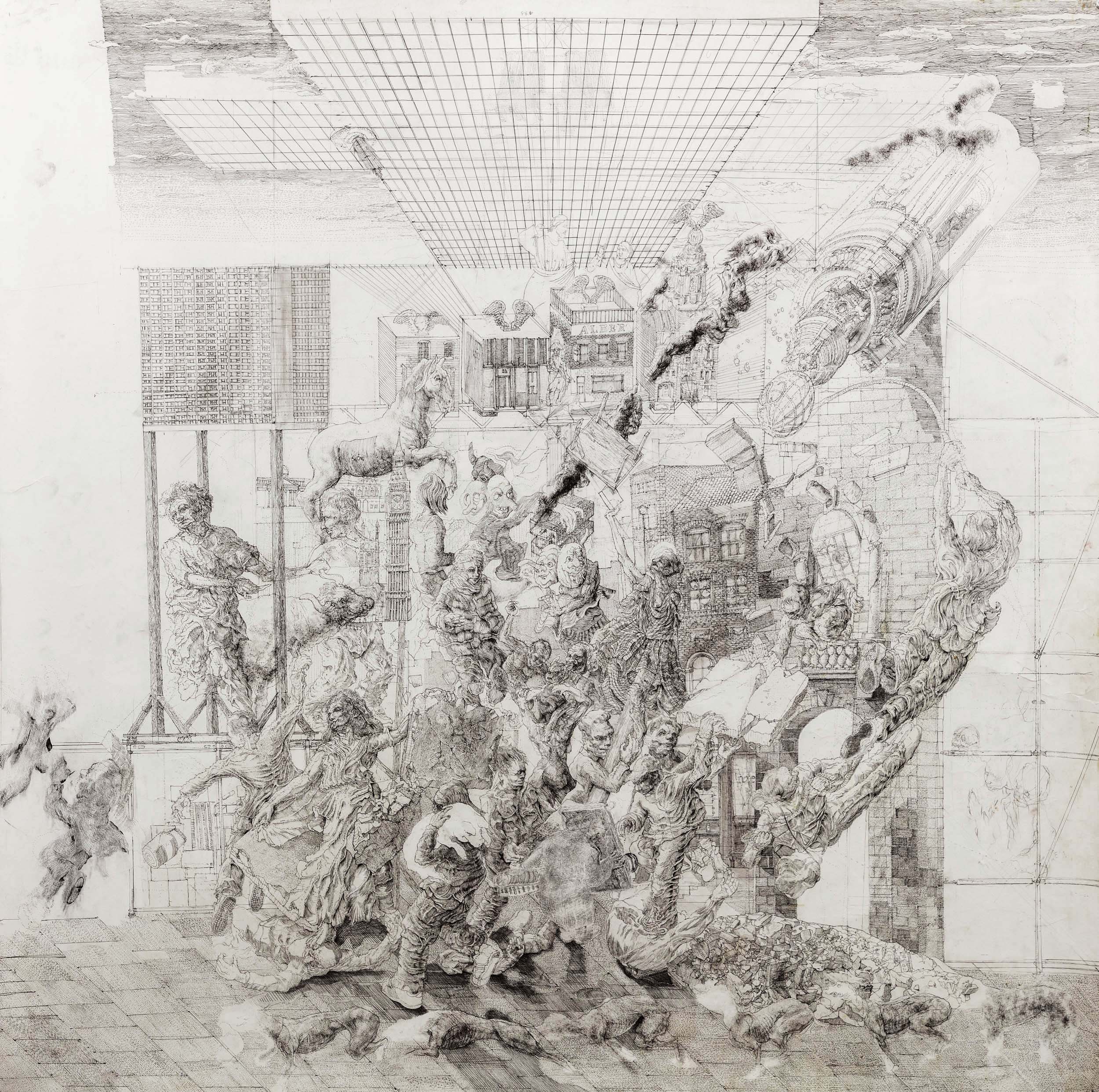
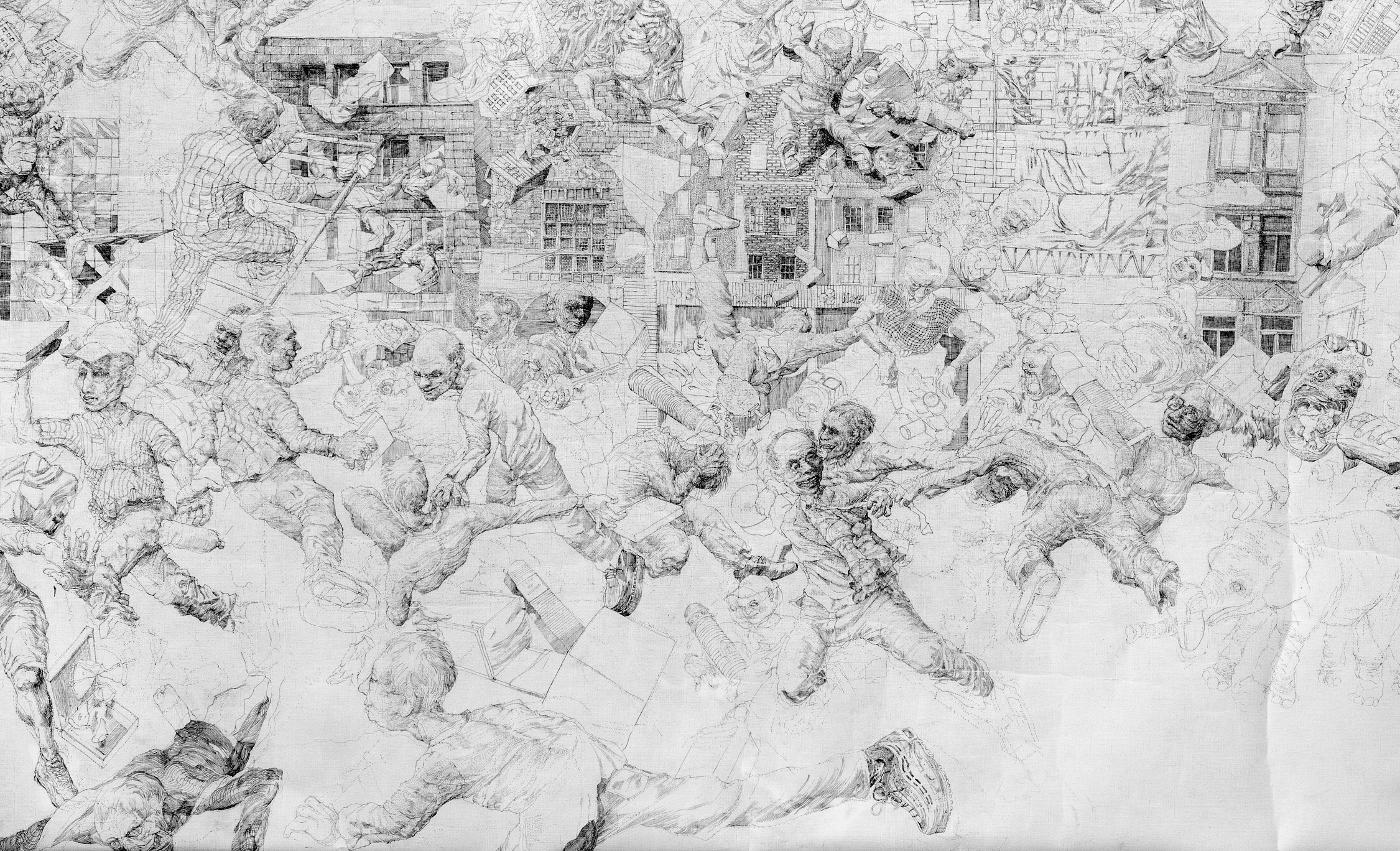
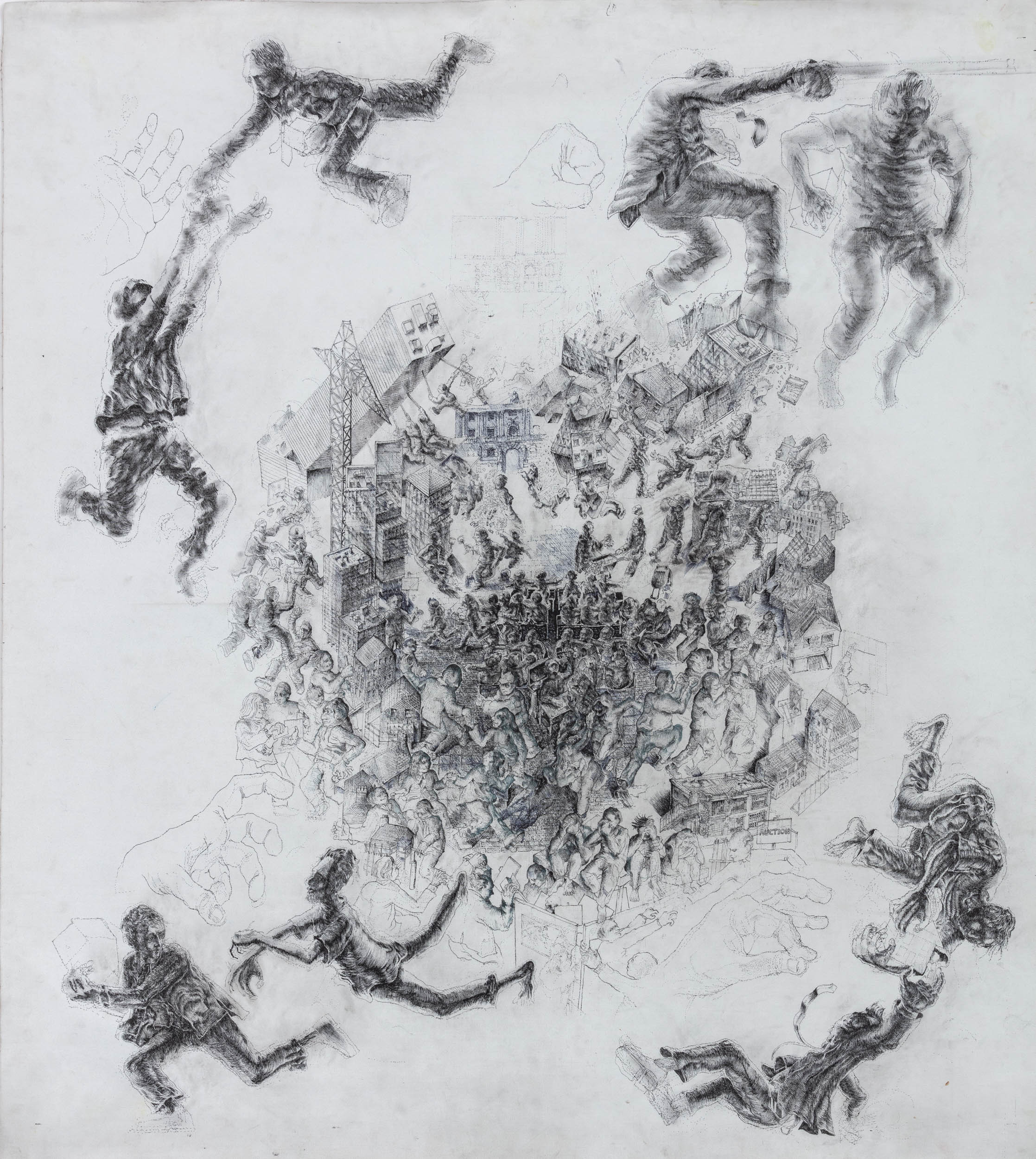
Capital at risk: Drawing the City of London
The artwork is set in the space between the city of London and Liverpool Street Station. The UK is the world’s largest exporter of financial services. Today, the departure from the European Union and the rise of distributed working have put the capital’s position at risk. There is also an ongoing supranational struggle. Economies are racing for financial supremacy. Trade frictions are unfolding— the shadow banking sector has ballooned - bank-like activities (mainly lending) outside the traditional banking sector, beyond the eyes of regulators. The City of London sees new waves of turbulent, uncertain, novel, and ambiguous scenarios unfold almost daily.
Most of the city’s activities are opaque, but the city and its people are intertwined in invisible ways. People in the UK invest daily in the City of London, most commonly in their pensions. London property prices mirror the city’s earning potential. Stocks and gilts link to these funds.
Millions of interactions happen daily in the Square Mile, a small space with enormous annual economic output, amounting to a quarter of England’s GDP. In the city of London, all socioeconomic systems connect through competition; you will see the competition on the shop floor and the trading floor, from the retail bank to the Bank of England, the public houses and the pension funds, the insurance brokers, and the shadow banks. But Fights typically happen bureaucratically and, as such, are rarely represented. But I wanted to ask how we could visualise the complex web of ‘invisible hands’? The city prides itself on competition, so I decided to create a drawing showing a melee eruption in the streets between Liverpool Street and Bank Station, and the competition in the city of London's financial sector.
The artwork is set in the space between the city of London and Liverpool Street Station. The UK is the world’s largest exporter of financial services. Today, the departure from the European Union and the rise of distributed working have put the capital’s position at risk. There is also an ongoing supranational struggle. Economies are racing for financial supremacy. Trade frictions are unfolding— the shadow banking sector has ballooned - bank-like activities (mainly lending) outside the traditional banking sector, beyond the eyes of regulators. The City of London sees new waves of turbulent, uncertain, novel, and ambiguous scenarios unfold almost daily.
Most of the city’s activities are opaque, but the city and its people are intertwined in invisible ways. People in the UK invest daily in the City of London, most commonly in their pensions. London property prices mirror the city’s earning potential. Stocks and gilts link to these funds.
Millions of interactions happen daily in the Square Mile, a small space with enormous annual economic output, amounting to a quarter of England’s GDP. In the city of London, all socioeconomic systems connect through competition; you will see the competition on the shop floor and the trading floor, from the retail bank to the Bank of England, the public houses and the pension funds, the insurance brokers, and the shadow banks. But Fights typically happen bureaucratically and, as such, are rarely represented. But I wanted to ask how we could visualise the complex web of ‘invisible hands’? The city prides itself on competition, so I decided to create a drawing showing a melee eruption in the streets between Liverpool Street and Bank Station, and the competition in the city of London's financial sector.
The scene is entirely imagined andwas drawn without life models. But references motifs and
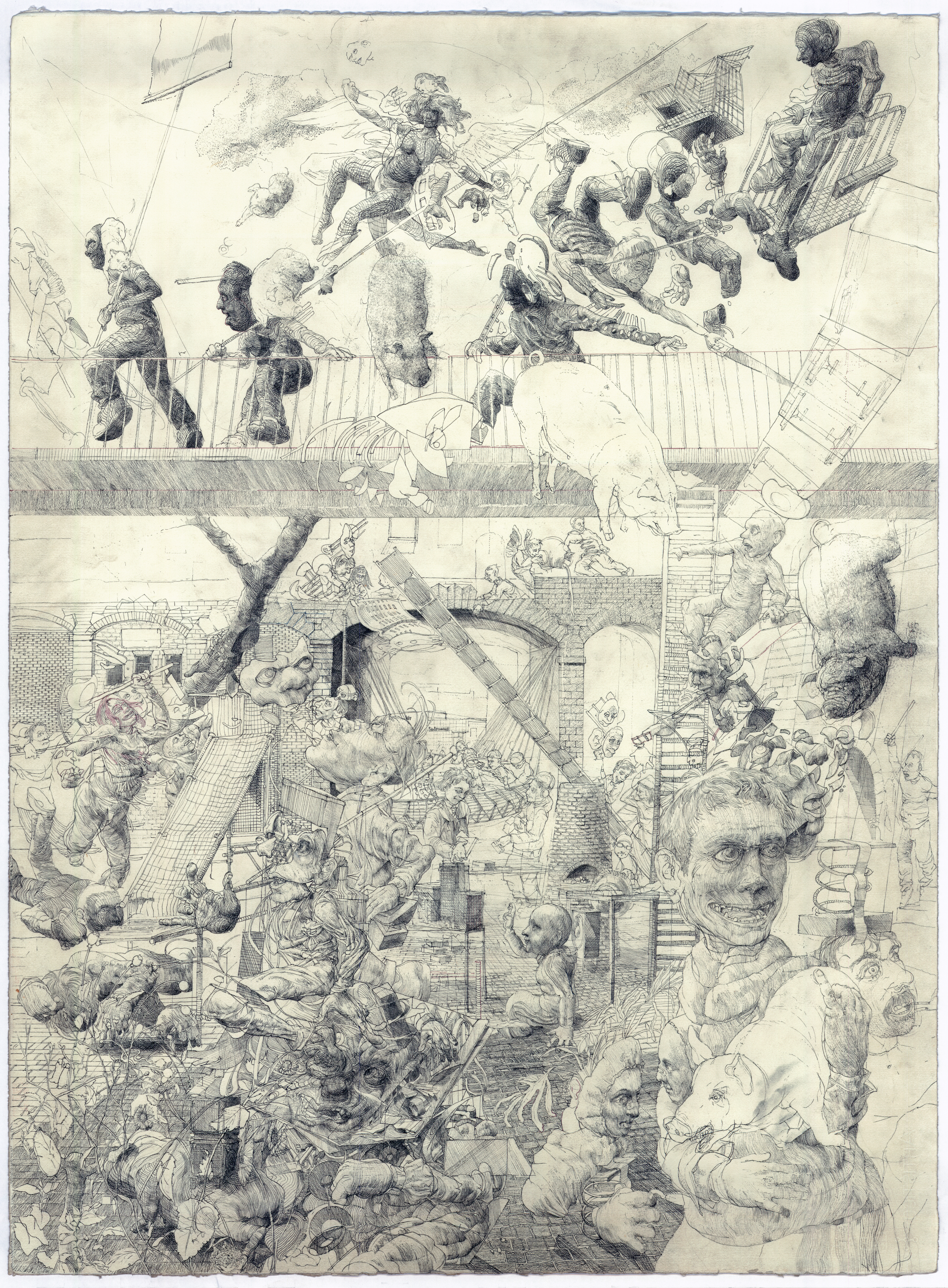


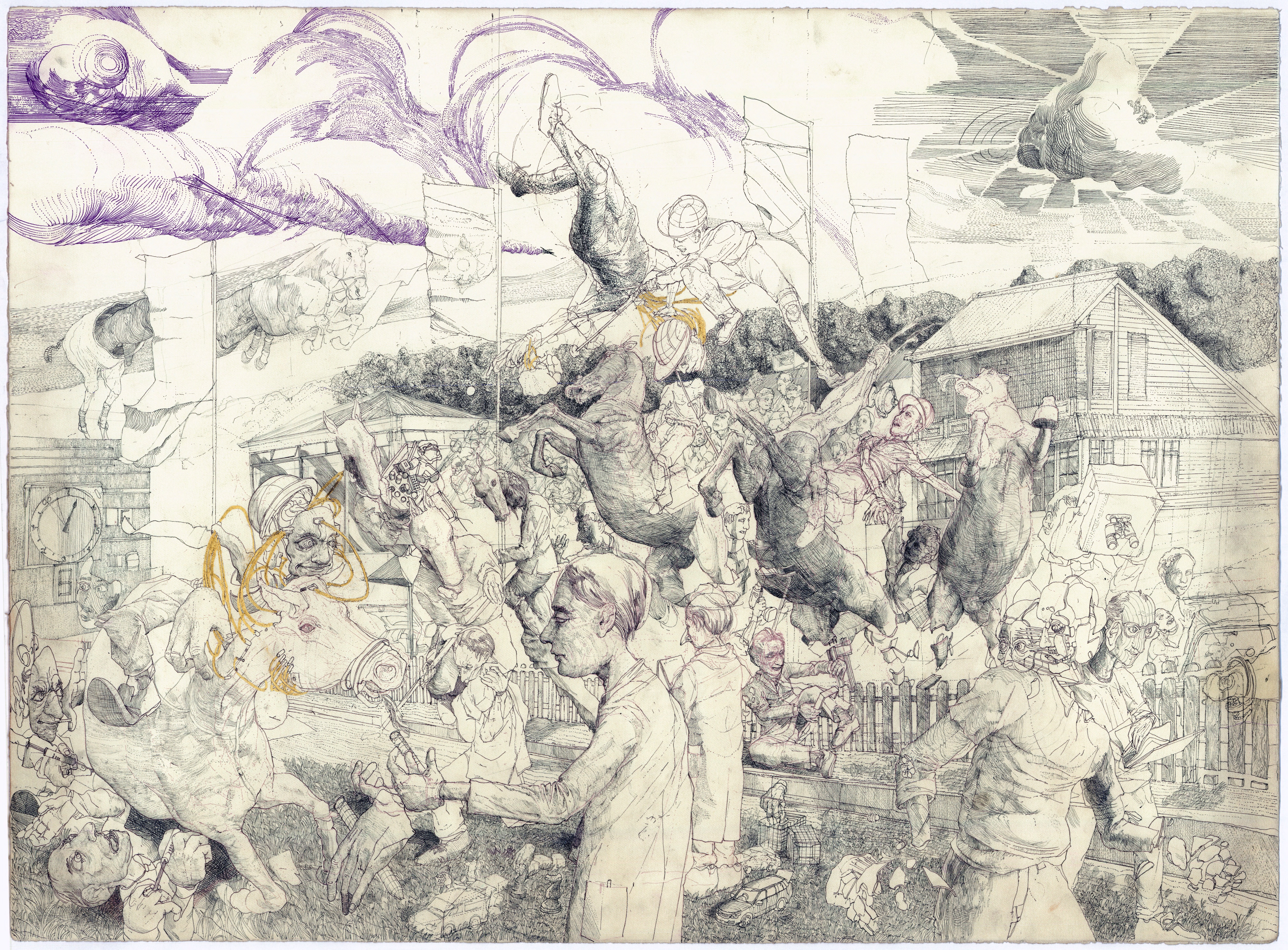


Society of the speculator :
Drawing speculative finance and its media relationship.
Today’s speculative economy is rooted in the foundations of a previous era. Flashback to 1980, and we saw the formation of Citibank: a merger between traditional finance and riskier speculative finance. From this point on, the evolution of Cheap credit and the expansion of globalisation created a discrepancy between the operating economy and the economy of value speculation. These two should never be too far apart.
The image is a summarization of the social and economic fabric. Above the clouds you see a levitated celestial fight scene unfolding around a floating Citibank and J.P. Morgan. Suspended in mid-air, like a spaceship. The fight begins to spill over to earth and explodes between unsuspecting high-street retailers enjoying the fashion district.
As chaos unfolds, the left-hand side of the image shows the media reporting the scene; the reporter is none other than Peter Ohanrahahanrahan (from the 1990s popular comedy Brass Eye), who promptly tells the unsuspecting public misinformation that the financial inequality is because of some ‘other’ or ‘bogeymen’ - particularly those seeking refuge from war. Without critical thinking skills being taught in schools, the public just believe it at face value.
Today, the issues within the financial system are getting worse. With politicians exploiting the information discrepancy to avoid the root, systemic issues. spreading misinformation about the nature of the economics to capitalize themselves. The line between lie and reality becomes more blurred. Digital media becomes more centralized. The use of AI and bots creates complex perception ‘nudges’ over time as a system of multi level marketing. As speculative bubbles grow bigger, we also see social bubbles become foam - more isolating and individual. This was supposed to be the future.
Drawing speculative finance and its media relationship.
Today’s speculative economy is rooted in the foundations of a previous era. Flashback to 1980, and we saw the formation of Citibank: a merger between traditional finance and riskier speculative finance. From this point on, the evolution of Cheap credit and the expansion of globalisation created a discrepancy between the operating economy and the economy of value speculation. These two should never be too far apart.
The image is a summarization of the social and economic fabric. Above the clouds you see a levitated celestial fight scene unfolding around a floating Citibank and J.P. Morgan. Suspended in mid-air, like a spaceship. The fight begins to spill over to earth and explodes between unsuspecting high-street retailers enjoying the fashion district.
As chaos unfolds, the left-hand side of the image shows the media reporting the scene; the reporter is none other than Peter Ohanrahahanrahan (from the 1990s popular comedy Brass Eye), who promptly tells the unsuspecting public misinformation that the financial inequality is because of some ‘other’ or ‘bogeymen’ - particularly those seeking refuge from war. Without critical thinking skills being taught in schools, the public just believe it at face value.
Today, the issues within the financial system are getting worse. With politicians exploiting the information discrepancy to avoid the root, systemic issues. spreading misinformation about the nature of the economics to capitalize themselves. The line between lie and reality becomes more blurred. Digital media becomes more centralized. The use of AI and bots creates complex perception ‘nudges’ over time as a system of multi level marketing. As speculative bubbles grow bigger, we also see social bubbles become foam - more isolating and individual. This was supposed to be the future.
The scene is entirely imagined, and was drawn without life models. But references motifs and
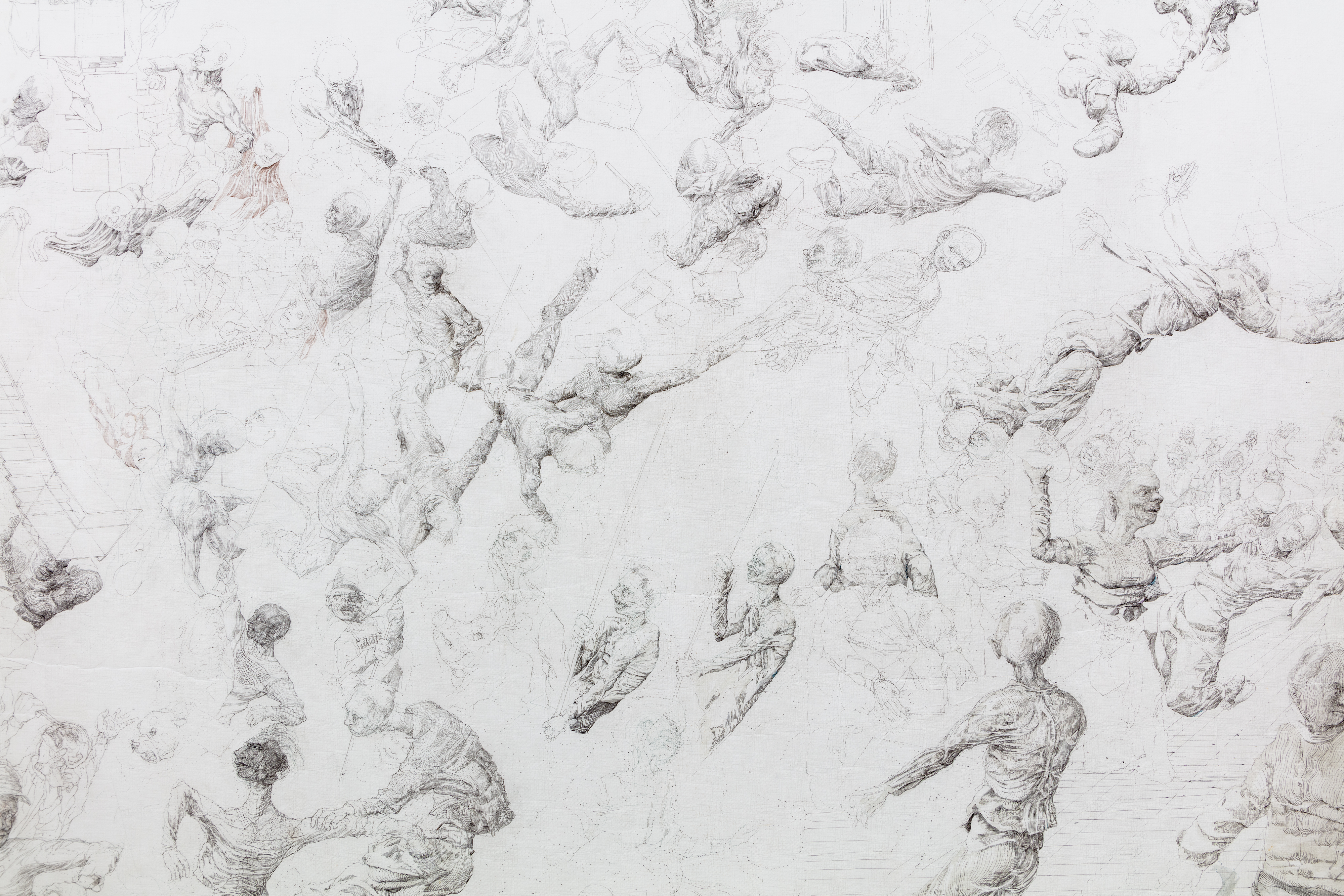


Doomscroll.
Doomscroll depicts an ongoing psychological battle between machine learning and humankind. Many leading technology experts believe that the next five years will completely decimate white-collar jobs. The rapid advancements of machine learning are already becoming visible.
The artwork touches on how gambling algorithms are engineered into social media design, The rise of formulaic artworks because of these pressures. The evolution of engagement farming culture.It explores symbolism and lost culture, Etruscan, The bayeux tapestry in Normandy. Heterotopias in modern italy and today's animal crossing are linked as “low probability connections’ essential to human understanding storytelling. The artwork concludes with references to Gödels theorem - how the logics for theoretical physics will in turn illuminate new paths for thinking about the arts.
The scene is entirely imagined, and was drawn without life models. But references motifs and
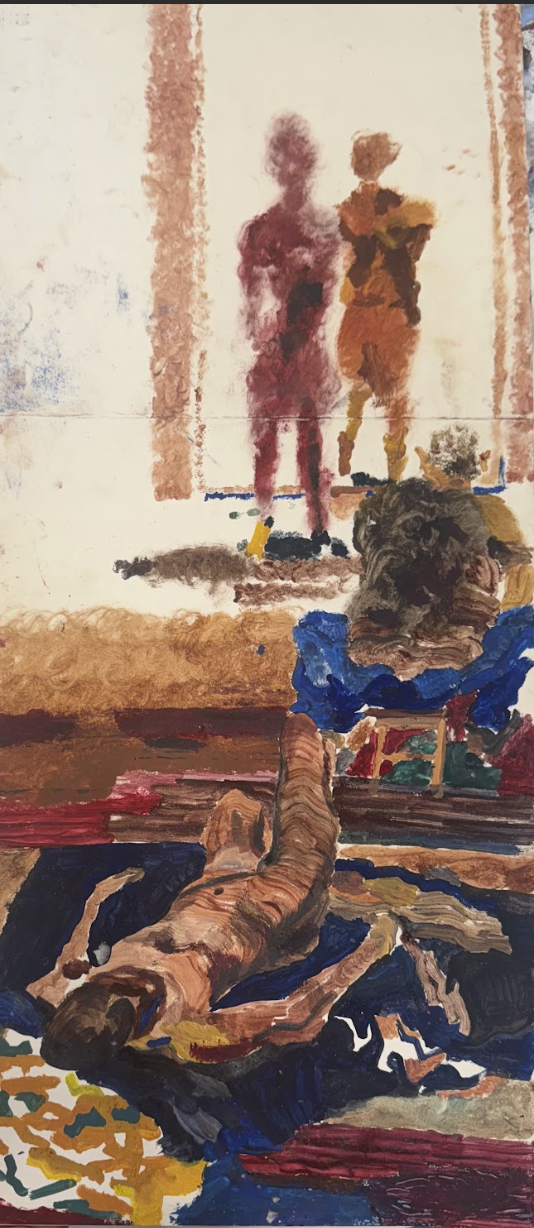


This drawing shows central London's art belt. It observes how social structures transform art from an image to a speculative commodity in the world's third-largest art market.
The bottom of the image shows the evolution of visual language as a relationship with trade and industrial history, which is distinctive to the place. The armoury trade, the printing press, the shipping and mercantile industry, and the lending industry are all shown in the Royal Academy of Arts and the Frieze Art Fair is shown as contextual and historical forces.
Above this, multiple artists are seen battling to pass several layers of social consensus as they aim for their art to become an asset in the free market. The interior designers, who make up eighty per cent of today's collectors, are shown holding different dollhouses, convincing artists to make the equivalent of wallpaper. The educated collector from the previous generation is seen as a ghost, looking over in great sadness. Above them is Deutchebank, the world's most prominent institutional collector of art, representing artwork as a financial instrument, and behind them is Geneva Freeport, an art storage facility. To the right-hand side of the image, an asteroid belt of central London's galleries is depicted as award vendors. Providing endless filtering and intermediation of creativity. Award makers like mall galleries appear as Daleks, vaporising the confidence of artists so they become demoralised and work in corporate carriers like PWC, Goldman Sachs, or Deloitte instead. One man is saved from this through a twist of fortune, being baptised by an astronomical rise to fame because of timing and interest rates rise in the capital markets. Meanwhile, some of his peers are ruthlessly beaten down by the same market a year later without any real logic they understand.
Floating artists fall from the sky as they try to navigate the plethora of educational institutions, providing validation in exchange for capital: but in the institutions, there is pressure to use projection tracing to skip the learning process, skip learning with basic copied abstraction, and others skip learning with naive work; the choice is shown like a decision between three starter Pokémon as ways to avoid the hard road of learning. Alongside this, two of the three artists are shown to be supported by their uncle, and the uncle kicks the third down. Showing how art, once a nameless profession but one fairly paid has morphed into a named profession that’s unfairly paid leading to a lack of labour negotiation overall. Images are shown to be valued incorrectly by galleries who intentionally misunderstand neoclassical economic logic in order to maintain social credence - proposing the value ascribed to the material basis of paint. Factories are seen making paintings alongside them. Hidden in the crowd is the 19th-century British economist Gabriel Tarde, who is at his desk with a lion, a reference to Saint Jerome, neither Adam Smith nor Marx.Tarde contributes an anthropological ground to the discourse of economics which has been widely overlooked: writing that integral value is based on beauty, knowledge, and utility. And that economies are a science of passionate interest. This maintains the positionality that while value may be ethereal it is wholly integral and not speculative. In other words, ‘wheat is wheat.’
Above all this, a chain of consecutive people clamber on ‘mind clouds’ in reach towards Ascendance. Speculators on top of other speculators. At the top of the image, we see a cameo by the young British artists who, now old, have ascended so far up that they are gatekeepers -, an intern is forced into taking cocaine as a sort of frat house ritual. As art functions only to evidence its godlessness, a multitude of day traders who Look over Geneva Freeport try to destroy anybody who shifts the narrative in a way that is against hedonism and debauchery, a sort of aggressive drug-fueled jealousy and evil anger. This is based on the incentive thay they are invested in a single idea of of progressive art which throws away history, to the detriment of other ideas of substantiated progress.
The bottom of the image shows the evolution of visual language as a relationship with trade and industrial history, which is distinctive to the place. The armoury trade, the printing press, the shipping and mercantile industry, and the lending industry are all shown in the Royal Academy of Arts and the Frieze Art Fair is shown as contextual and historical forces.
Above this, multiple artists are seen battling to pass several layers of social consensus as they aim for their art to become an asset in the free market. The interior designers, who make up eighty per cent of today's collectors, are shown holding different dollhouses, convincing artists to make the equivalent of wallpaper. The educated collector from the previous generation is seen as a ghost, looking over in great sadness. Above them is Deutchebank, the world's most prominent institutional collector of art, representing artwork as a financial instrument, and behind them is Geneva Freeport, an art storage facility. To the right-hand side of the image, an asteroid belt of central London's galleries is depicted as award vendors. Providing endless filtering and intermediation of creativity. Award makers like mall galleries appear as Daleks, vaporising the confidence of artists so they become demoralised and work in corporate carriers like PWC, Goldman Sachs, or Deloitte instead. One man is saved from this through a twist of fortune, being baptised by an astronomical rise to fame because of timing and interest rates rise in the capital markets. Meanwhile, some of his peers are ruthlessly beaten down by the same market a year later without any real logic they understand.
Floating artists fall from the sky as they try to navigate the plethora of educational institutions, providing validation in exchange for capital: but in the institutions, there is pressure to use projection tracing to skip the learning process, skip learning with basic copied abstraction, and others skip learning with naive work; the choice is shown like a decision between three starter Pokémon as ways to avoid the hard road of learning. Alongside this, two of the three artists are shown to be supported by their uncle, and the uncle kicks the third down. Showing how art, once a nameless profession but one fairly paid has morphed into a named profession that’s unfairly paid leading to a lack of labour negotiation overall. Images are shown to be valued incorrectly by galleries who intentionally misunderstand neoclassical economic logic in order to maintain social credence - proposing the value ascribed to the material basis of paint. Factories are seen making paintings alongside them. Hidden in the crowd is the 19th-century British economist Gabriel Tarde, who is at his desk with a lion, a reference to Saint Jerome, neither Adam Smith nor Marx.Tarde contributes an anthropological ground to the discourse of economics which has been widely overlooked: writing that integral value is based on beauty, knowledge, and utility. And that economies are a science of passionate interest. This maintains the positionality that while value may be ethereal it is wholly integral and not speculative. In other words, ‘wheat is wheat.’
Above all this, a chain of consecutive people clamber on ‘mind clouds’ in reach towards Ascendance. Speculators on top of other speculators. At the top of the image, we see a cameo by the young British artists who, now old, have ascended so far up that they are gatekeepers -, an intern is forced into taking cocaine as a sort of frat house ritual. As art functions only to evidence its godlessness, a multitude of day traders who Look over Geneva Freeport try to destroy anybody who shifts the narrative in a way that is against hedonism and debauchery, a sort of aggressive drug-fueled jealousy and evil anger. This is based on the incentive thay they are invested in a single idea of of progressive art which throws away history, to the detriment of other ideas of substantiated progress.
The scene is entirely imagined, and was drawn without life models. But references motifs and

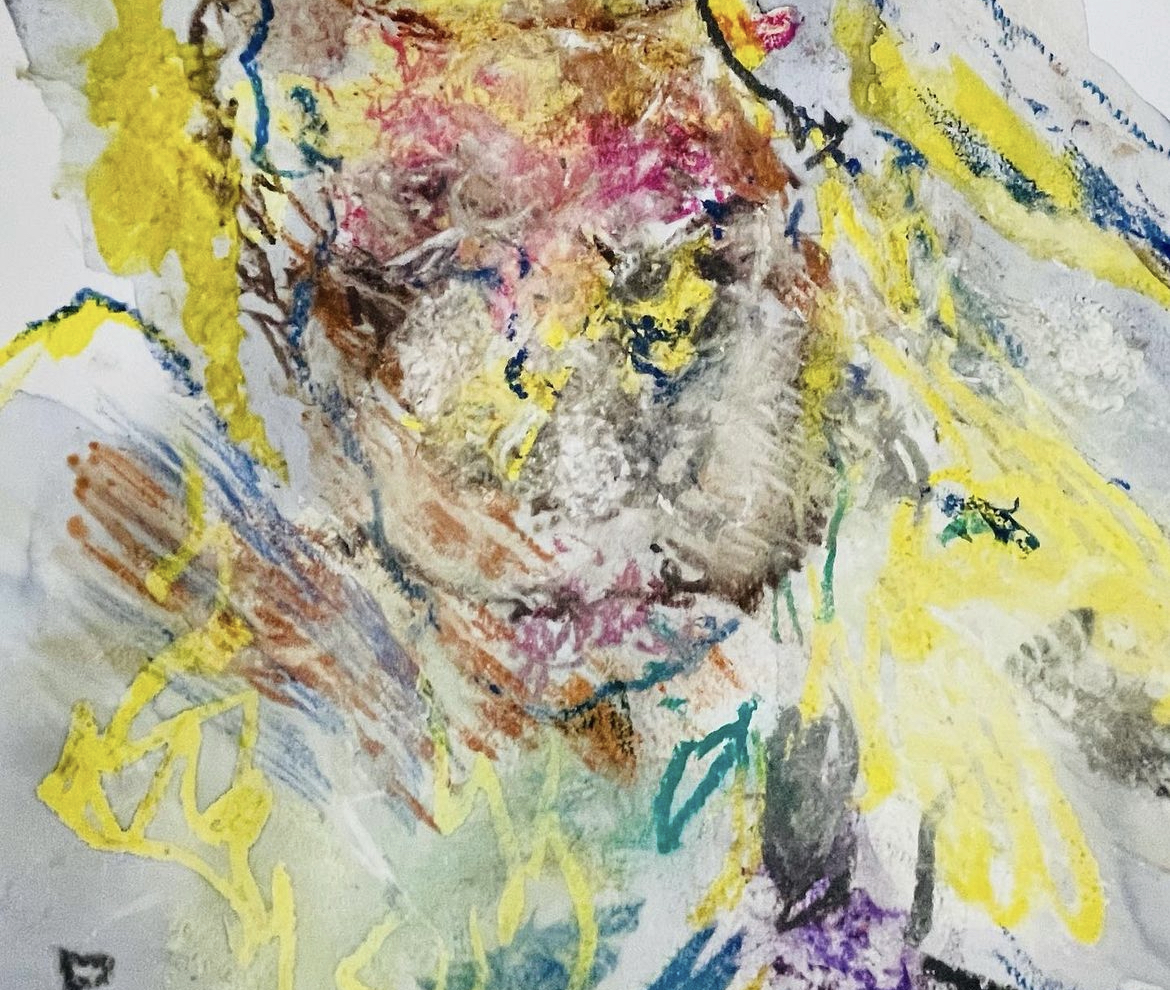

Peak interest: London housing cycle and its social effect. 2023 (System drawing)
London’s credit cycle guides allocation of capital. In practice this means a credit cycle is more than just money, it is a driving of social interactions and emotional experiences felt by millions in synchrony. The artwork shows the housing market cycle of London, the emotions and the social-economic relationships. It developed from my lived experience of the tragedy of London’s housing market, and my understanding of housing cycles from economic theory.
Low-interest rates led to hysteria. Housing became a speculative asset rather than being valued for use. Now a steep incline of interest rate turns the over-leveraged over to a panic, and a depression. Politicians propping the market with disastrous policies like the introduction of 40-year mortgages. The result is that we are experiencing the biggest wealth inequality since 1870.
In the past two years inflation struck because of excessive money in circulation which linked to a drive-in prices, with too much money chasing too few goods. Now the assets of the middle classes are being eaten in small chunks and the lowest paid feel the worst effects, As a rising damp there is an increase of poorer living standards. Prospects of war rise, dissatisfied people quickly turn evil and the risk of human rights breaches increases.
Unemployment and economic hardship also affect the household level as financial depression is positively related to abusive behaviour. Further, rapid increases in the unemployment rate increase men's controlling behaviour toward romantic partners and unemployment and economic distress is caused at household level. We get marred in a boom and divorced in a crash.
In the downturn, the foreclosure wave will mean another great redistribution. as the market cycle acts as the invisible hand for the accumulation.But as a pinprick of hope, could see an increase in housing production after its all over.
London’s credit cycle guides allocation of capital. In practice this means a credit cycle is more than just money, it is a driving of social interactions and emotional experiences felt by millions in synchrony. The artwork shows the housing market cycle of London, the emotions and the social-economic relationships. It developed from my lived experience of the tragedy of London’s housing market, and my understanding of housing cycles from economic theory.
Low-interest rates led to hysteria. Housing became a speculative asset rather than being valued for use. Now a steep incline of interest rate turns the over-leveraged over to a panic, and a depression. Politicians propping the market with disastrous policies like the introduction of 40-year mortgages. The result is that we are experiencing the biggest wealth inequality since 1870.
In the past two years inflation struck because of excessive money in circulation which linked to a drive-in prices, with too much money chasing too few goods. Now the assets of the middle classes are being eaten in small chunks and the lowest paid feel the worst effects, As a rising damp there is an increase of poorer living standards. Prospects of war rise, dissatisfied people quickly turn evil and the risk of human rights breaches increases.
Unemployment and economic hardship also affect the household level as financial depression is positively related to abusive behaviour. Further, rapid increases in the unemployment rate increase men's controlling behaviour toward romantic partners and unemployment and economic distress is caused at household level. We get marred in a boom and divorced in a crash.
In the downturn, the foreclosure wave will mean another great redistribution. as the market cycle acts as the invisible hand for the accumulation.But as a pinprick of hope, could see an increase in housing production after its all over.


Journey to Goloka Vrindavan (2023), ink drawing, canvas
Growing up as a Hare Krishna devotee, every Sunday I would go to the temple in central London in Soho Square. The Hare Krishna religion is a non-materialist religion. Which deems the excess of material possessions as gross, something that stops you from reaching the liberated spiritual world. I wanted to create an image that depicts the conscious understanding of the place situated within the understanding of Hare Krishna: an auto-ethnographic piece depicting the way Oxford Street is perceived and the phenomenology of myth in relation to space. At the heart of the image is a struggle for transcendental realisation against the forces of the material world, where the familiar buildings of Oxford Street are just temporary material realities, represented here as a sort of dollhouse or model village.
On the left and in the sky are the symbolic references from the Bhagavad Gita, the scripture that forms the basis of the religion. Showing a fierce struggle between the consumers in Oxford Street and Hare Krishna's, the image echos the battle of Kurukshetra, the ethical precipice of the Vedas. The people on the ground represent the counterparts and different modes of material nature and their symptoms. The Hare Krishna devotees grapple with the means to escape through Kirtan (public song) and chanting (private meditation); along with them is Lord Chaitanya Mahaprabhu, dressed as a devotee. The most recent incarnation of Krishna was from Mayapur. On the left of the image is a banana tree. Krishna’s eternal abode, Goloka Vrindavana, is often shown with the upside-down tree below—a banyan tree. Which represents the material world as a perverted reflection of the spiritual world.
So above the banyan tree is Krishna as a child from the butter theif pastime. His mother, Yashoda, is chasing him. Surrounding him is the Dance of Divine Love (the Rasa Lila). He is pouring butter onto the devotees below, creating a flow that represents the thread of consciousness, the Java Attma, and landing on the light-emitting Lord Jagganath. This is the deity from the Shri Shri Radha London Ishvara temple, based in Soho Square. Below this is man being tugged away from the spiritual world by the five figures that represent the forces of illusion they pull at him with the strings of the five senses as he attempts to transcend from the material to the spiritual.


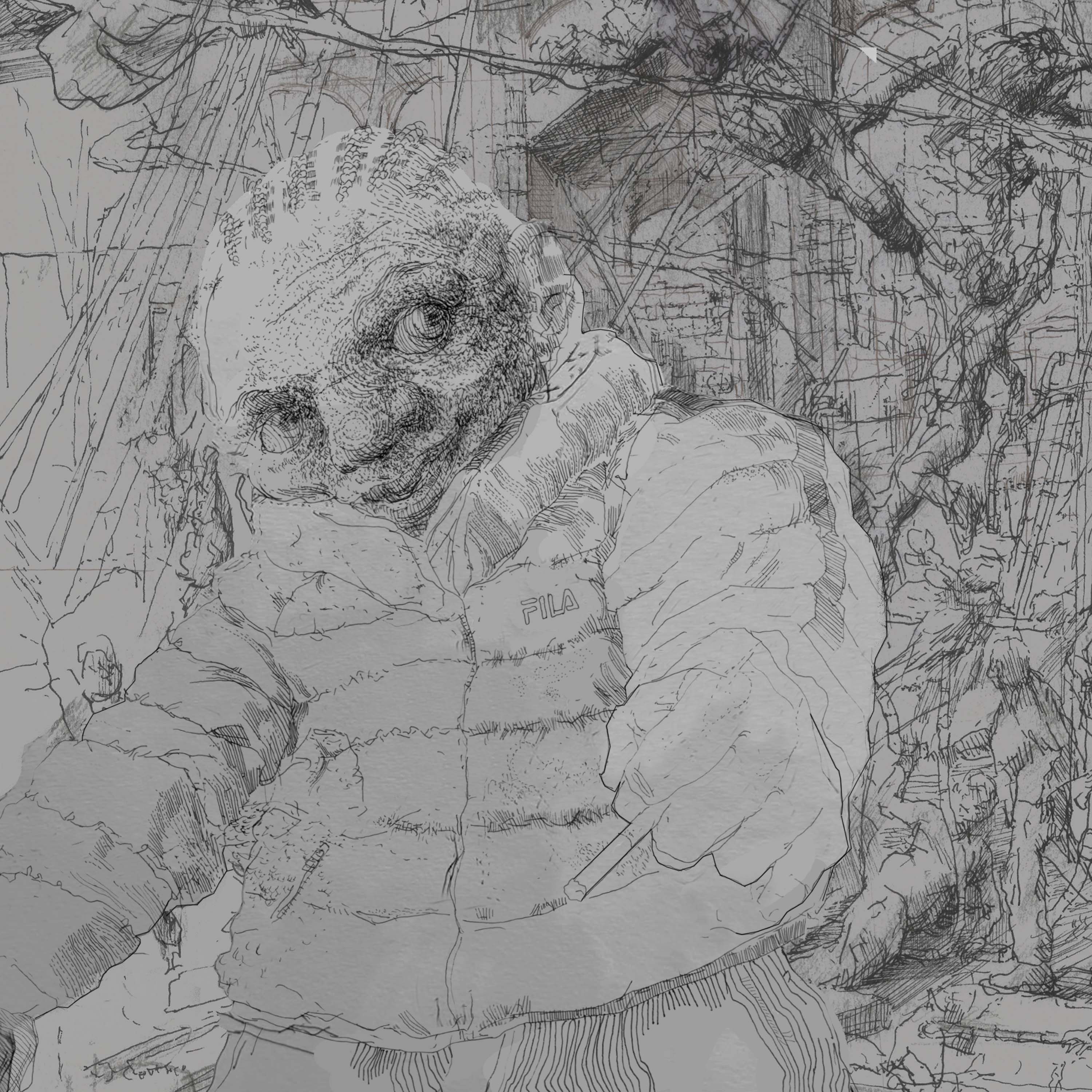

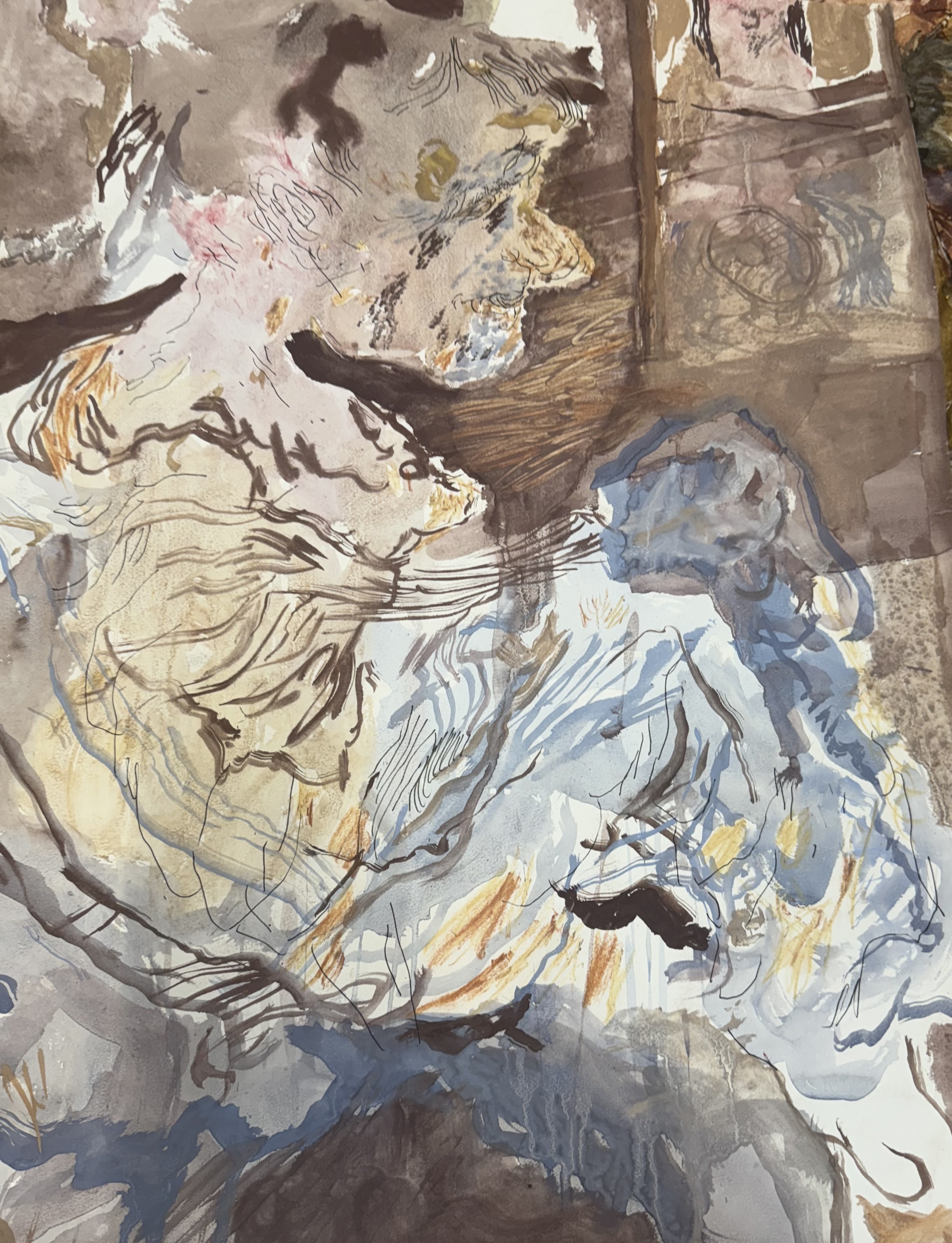
Midnight London:
Lost souls 🐱 cats and foxes 🦊






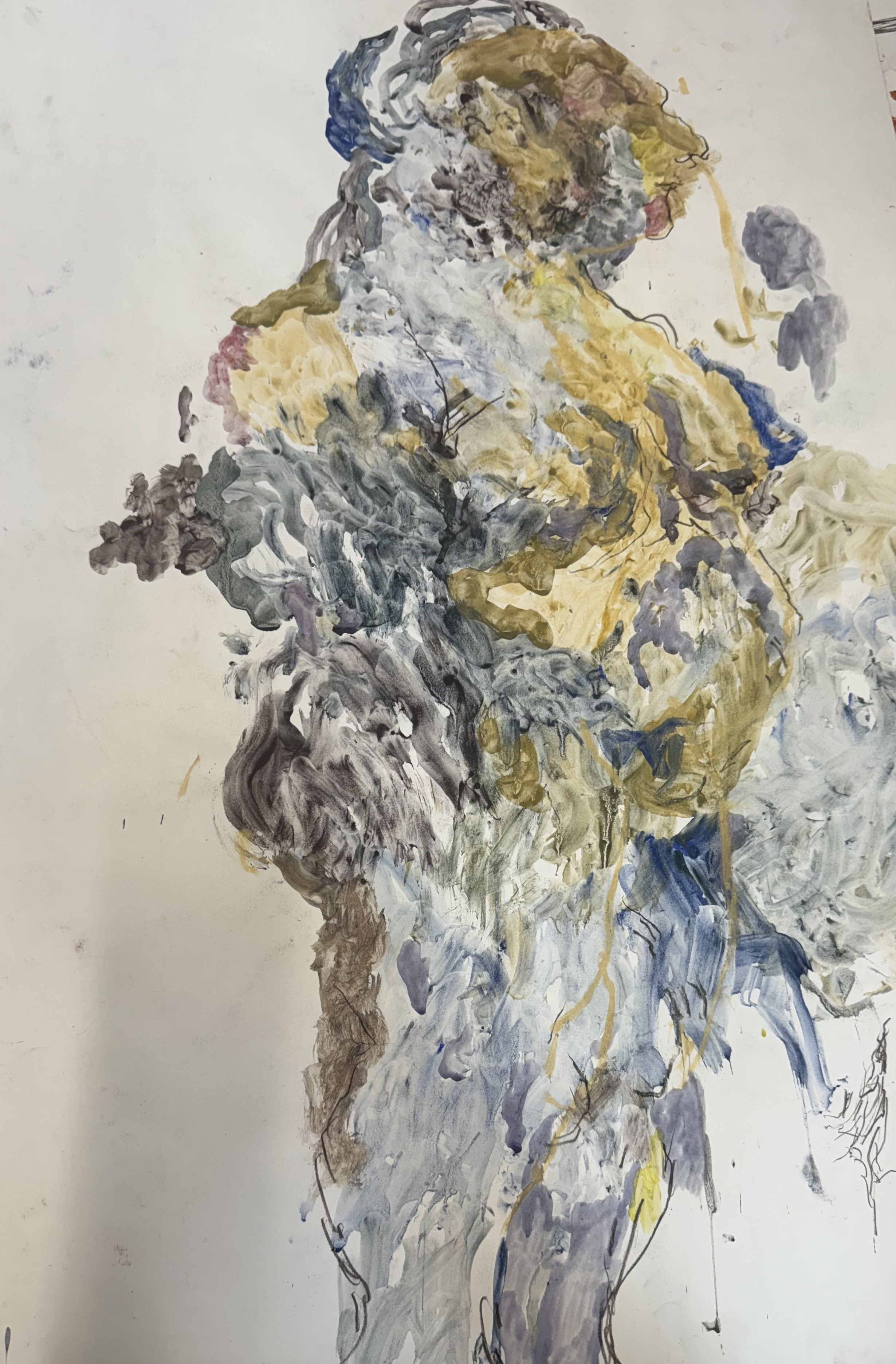


Peckham’s price inflation
The piece has a backdrop of a street in Peckham, where I’m living.
The shops steal from the people who need to eat - using sky high prices as a way of taking their milk, but the families of these shopkeepers need to eat too and the owners justify the price rises as they are paying to support their staff wages and children. The inequality of work and life balance leads to an excess of pressure on children. The marginalised, unpaid workforce that make up a bulk of domestic labor - are feeling the brunt of the mounting tension and declining support. This transforms into violence and theft in the streets as the social pressure is never one sided - all are affected by the economic conditions being locked in a price spiral without a happy ending. A wage-price spiral is the unseen theme affecting peaceful people to act in hostility to one another.
The figures in the drawing are all drawn from imagination and are loosely based on Poussins dancers. This etching that has has multiple stages, with variations of intaglio line, tone and aquatint.
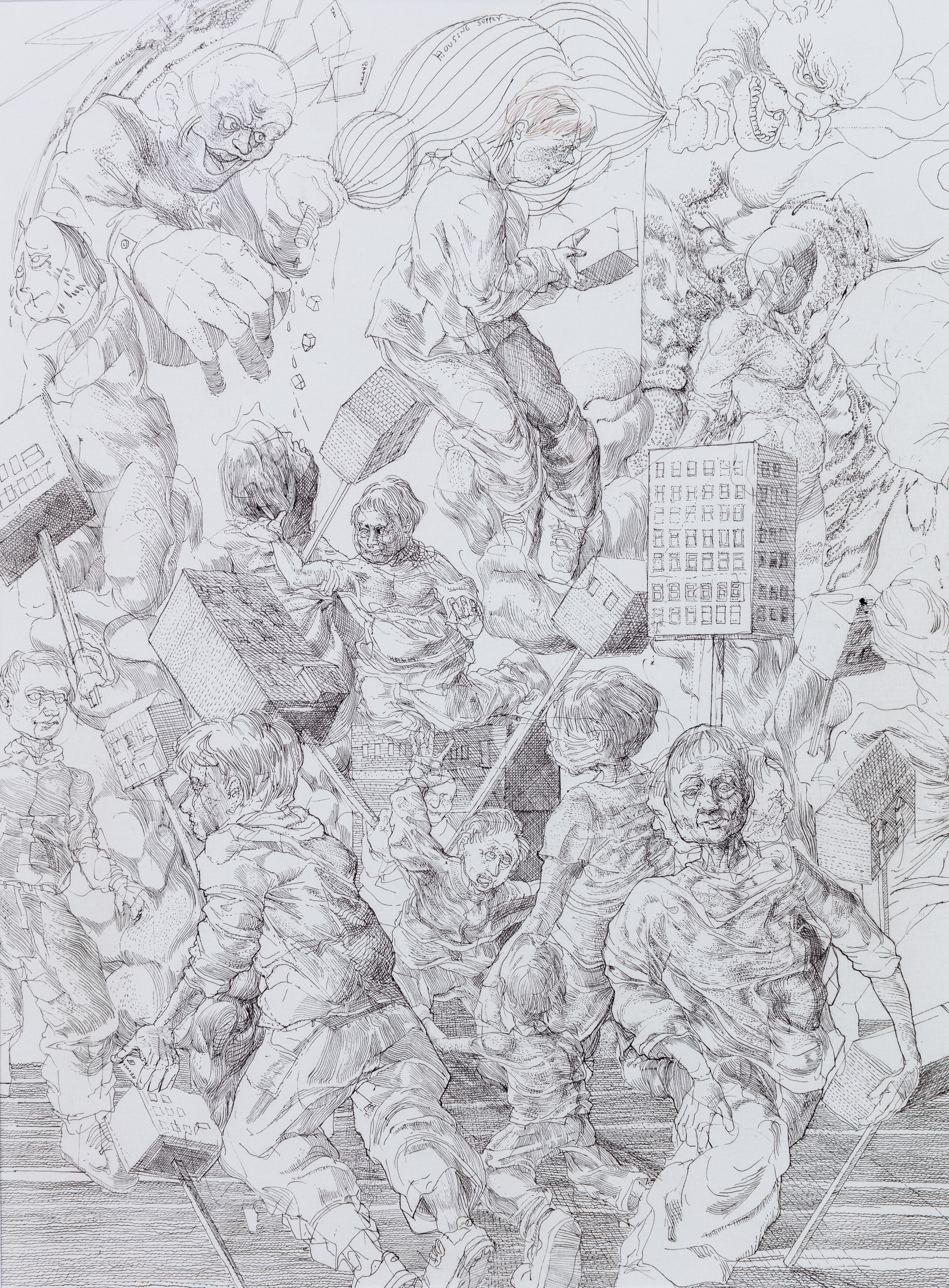
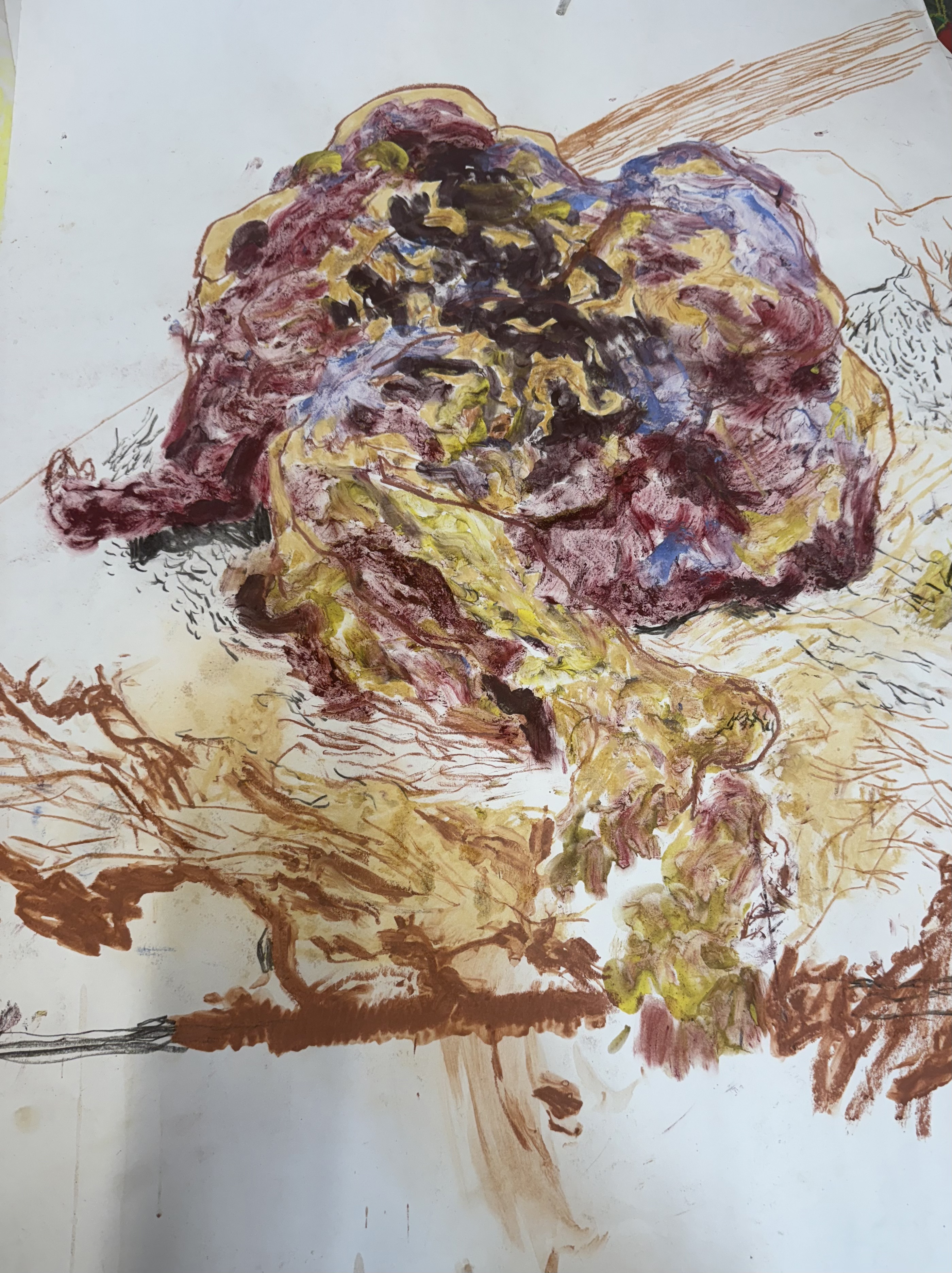

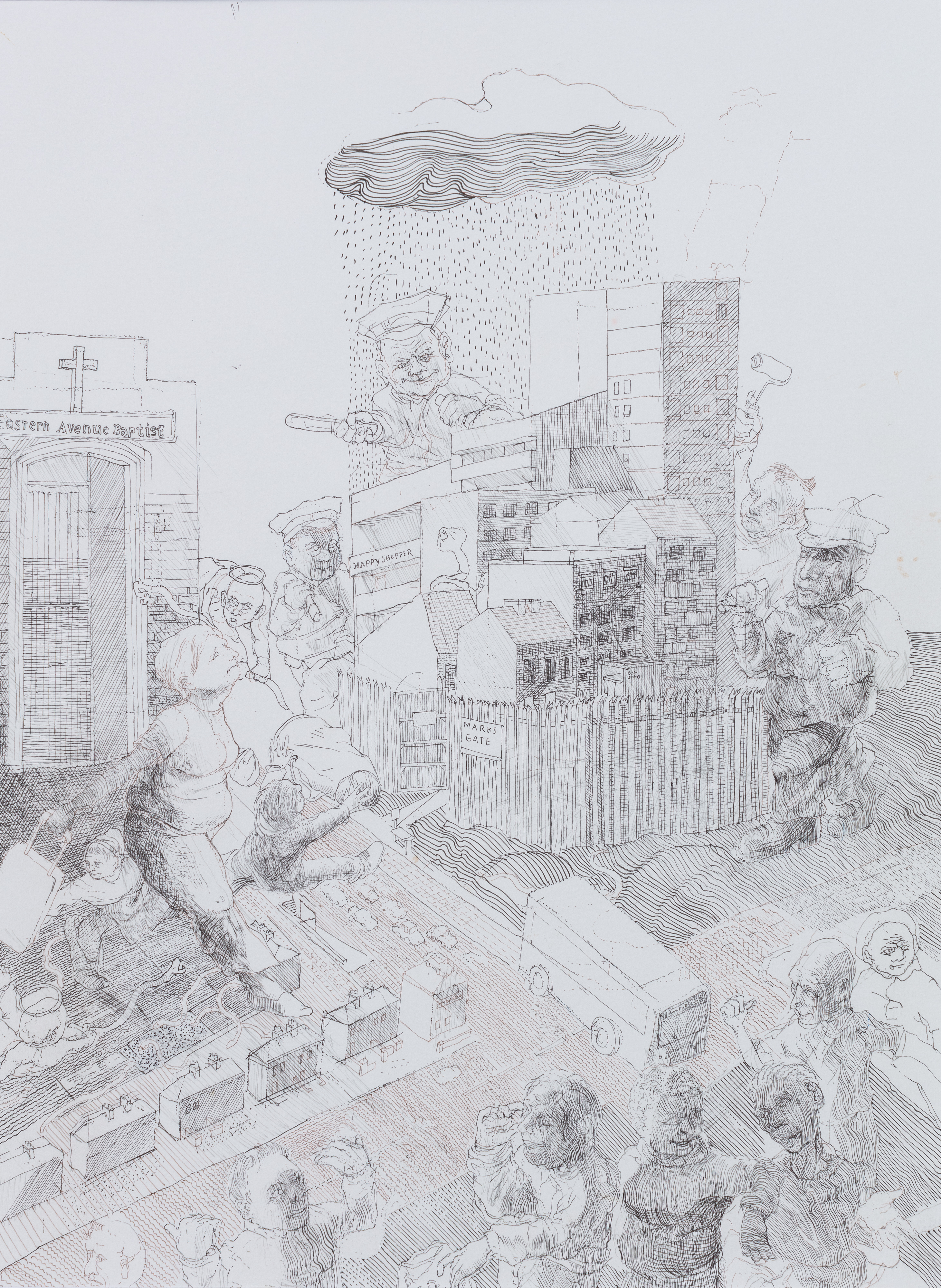

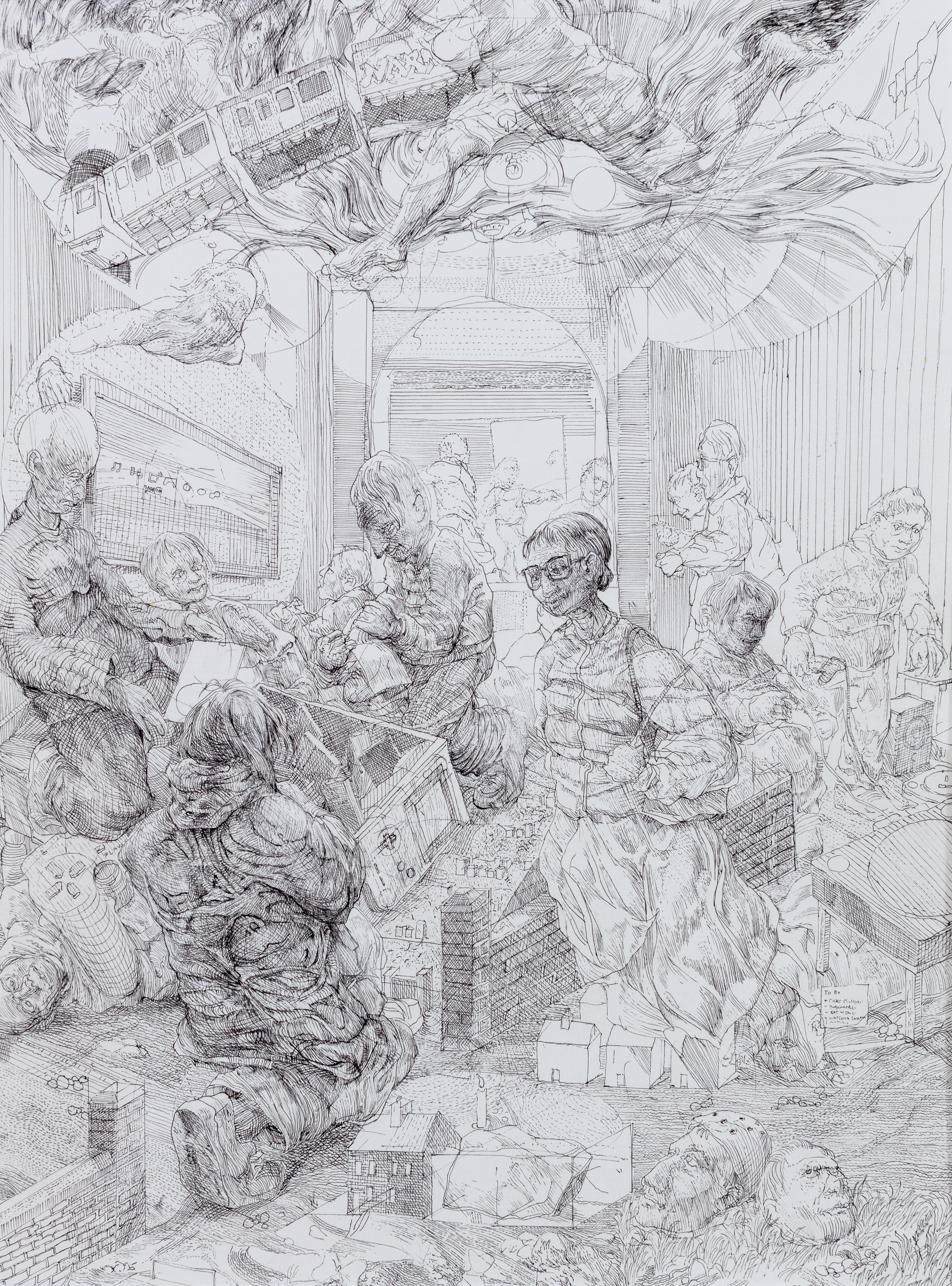

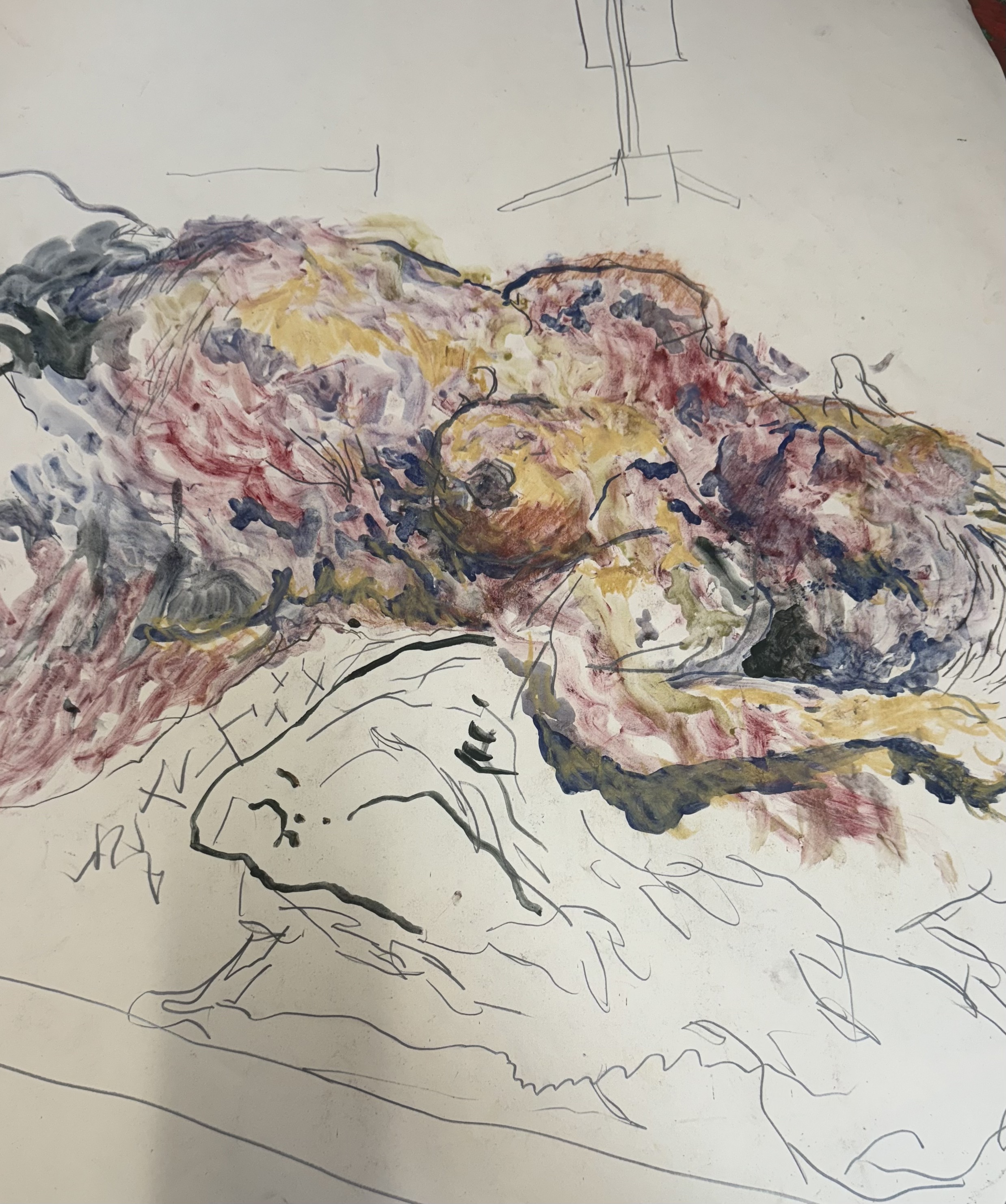

The language of vandalism has been assimilated into the visual language of the current generation. Vandalism is no longer a sublanguage or colloquialism - opressed resisting opressor. But rather has asserted itself as a valuable new means of expressing human emotion and human relationships. As the urban realm shows patterns and changes with layers of accretion these layers can be used to show the internal struggle of a human psyche. As materiality give a strong language of place, it’s effective use can manifest a new form portraiture and post-vandalist representation.
In the post-Vandalist figurativism, the image is developed as a process and relationship between material. Addition and subtraction, the buffing, the vandalism, the weathering, repeat. The language formed from cracked wall, layered bright scrawls, the opaque musty grey of recent buffing, red paint, scrawls of white emulsion paint, the damaged surfaces showing aggregate underneath, bolts and steel, the etching, blotches of ink, iron oxide, chalk, copper, plastic-based paint, water-raging plywood, spots of mould and algae weathering, salts and spalling, petroleum based paint, mortar and layers of gypsum, tar, stickers and vertical cracks, clay, feathered velvety spray paint, direct clean surfaces.
These material relationships of London are the new grammar that can be used in new poetry, which enables us to reflect new layers of understanding between humans and environment. Just as ambient and noise artists use sampling to create new music. The material juxtapositions can ignite a familiarity, that allows cognitive behavioural chords unique to the new generation - expressing the inner psychological states which are otherwise not expressed. Aswell as changes in a person. The urban is an environmental relationshionships and our sensorial adaptation to this is the phenomenology of the contemporary human- therefore it is the language of the new.
The Arts Cancel’ - 202

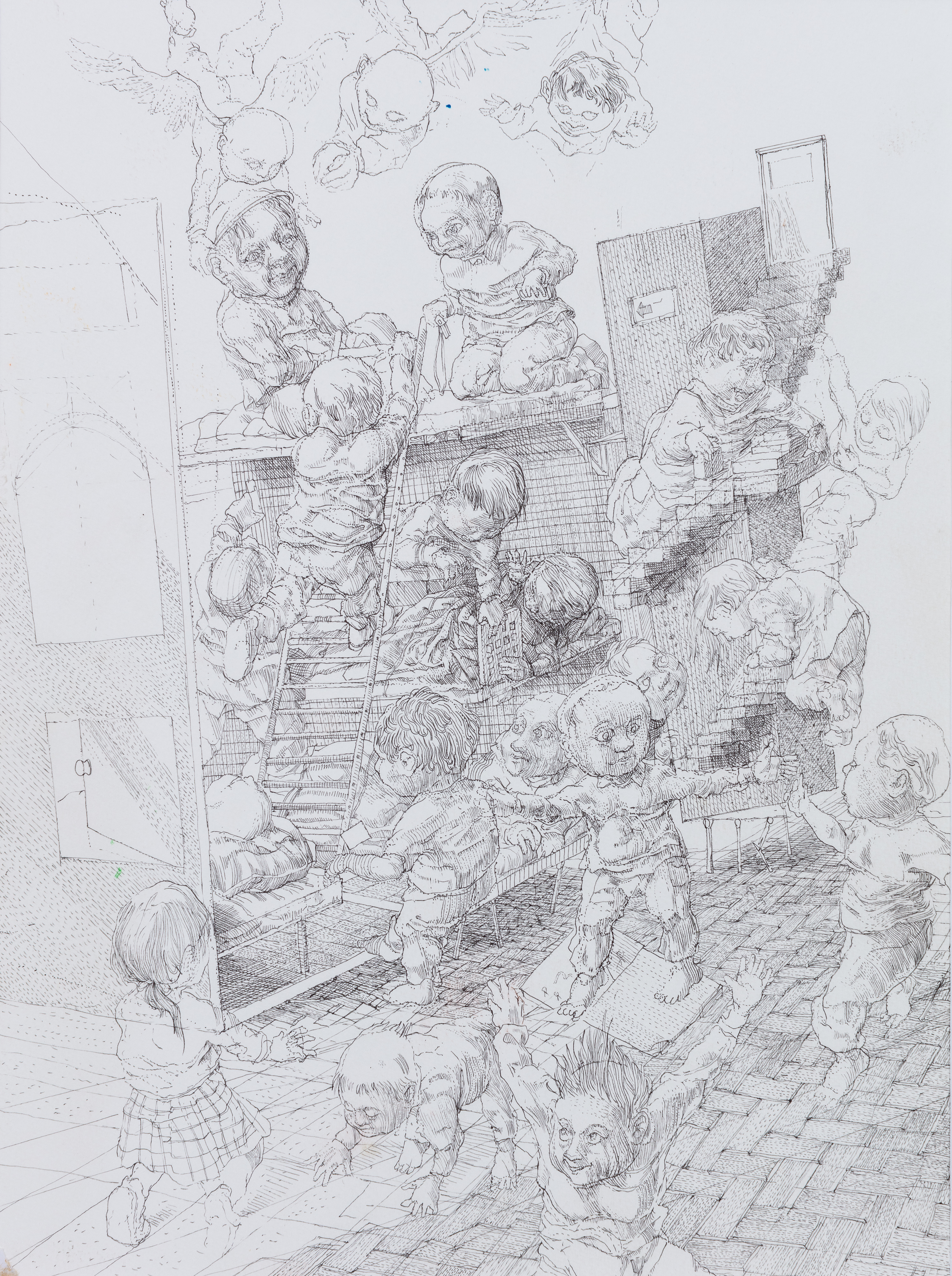


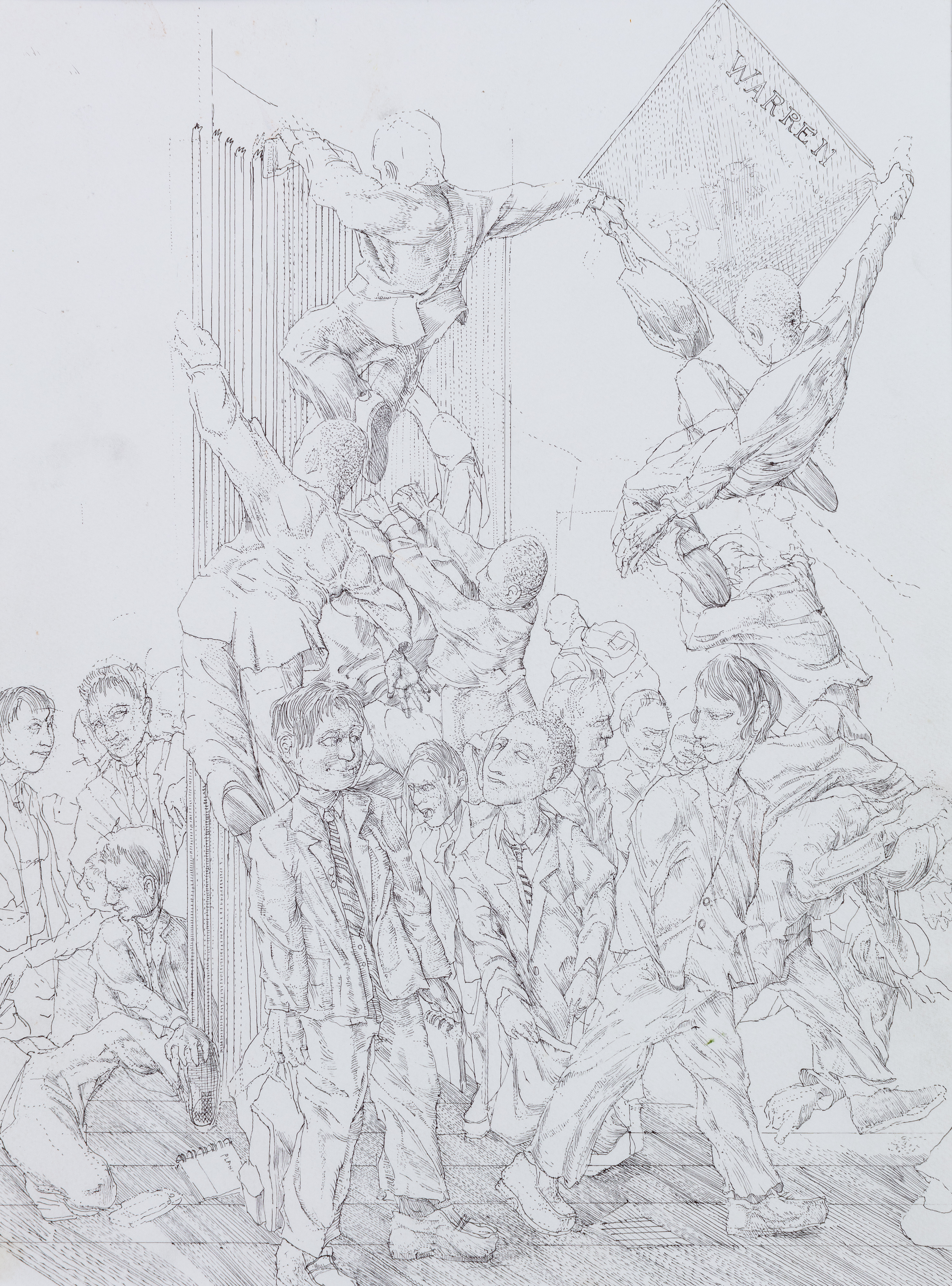


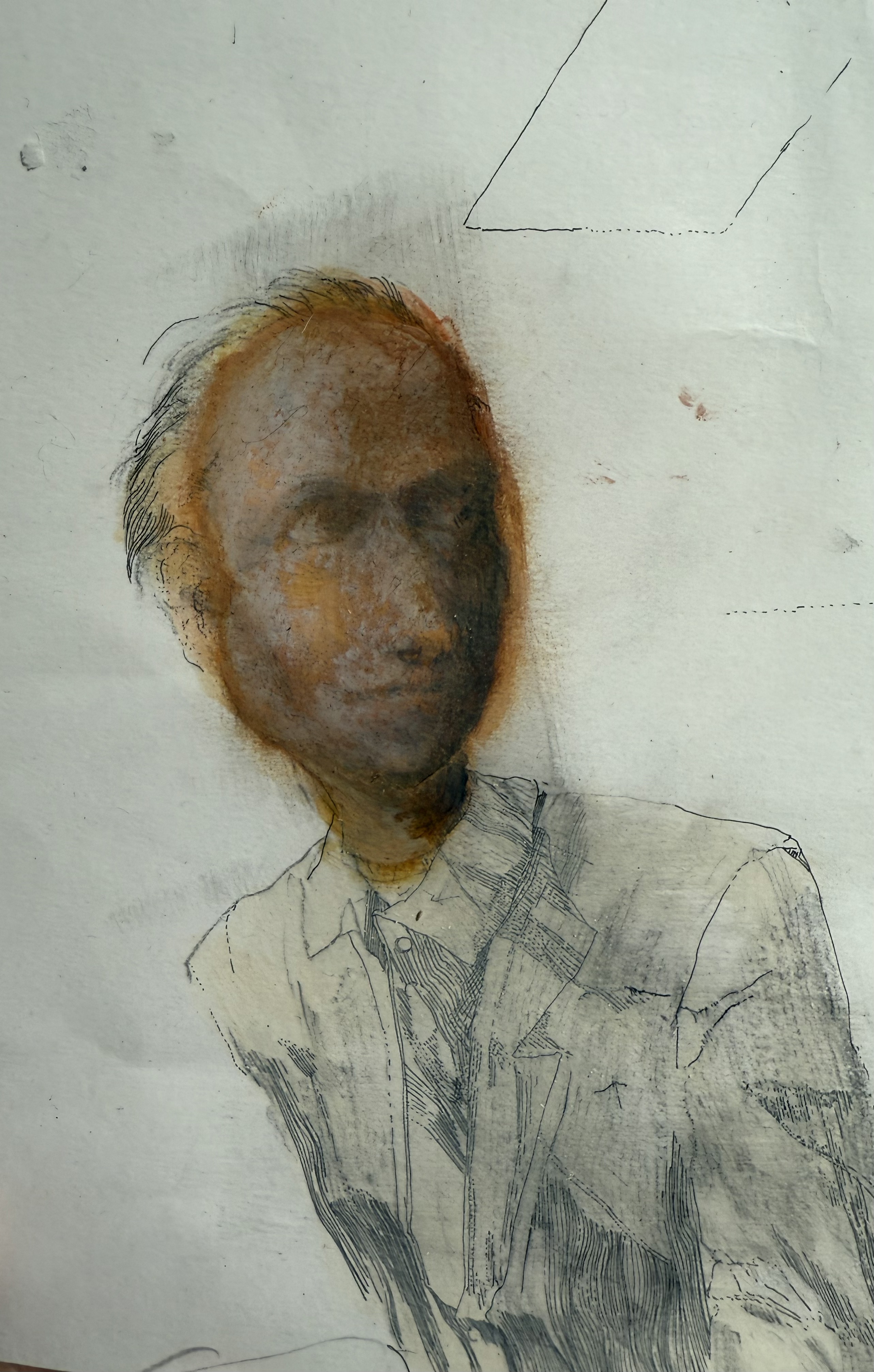


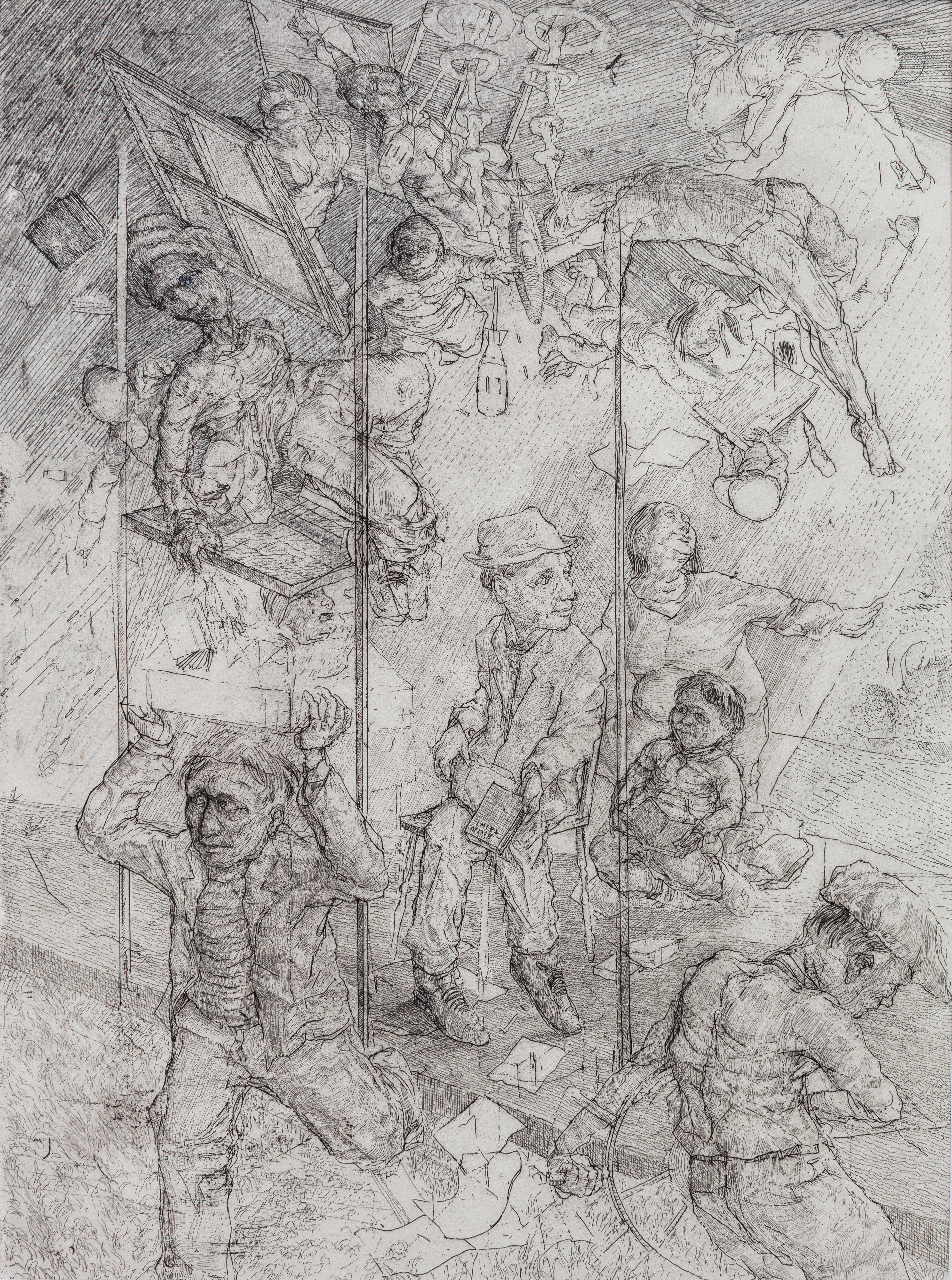

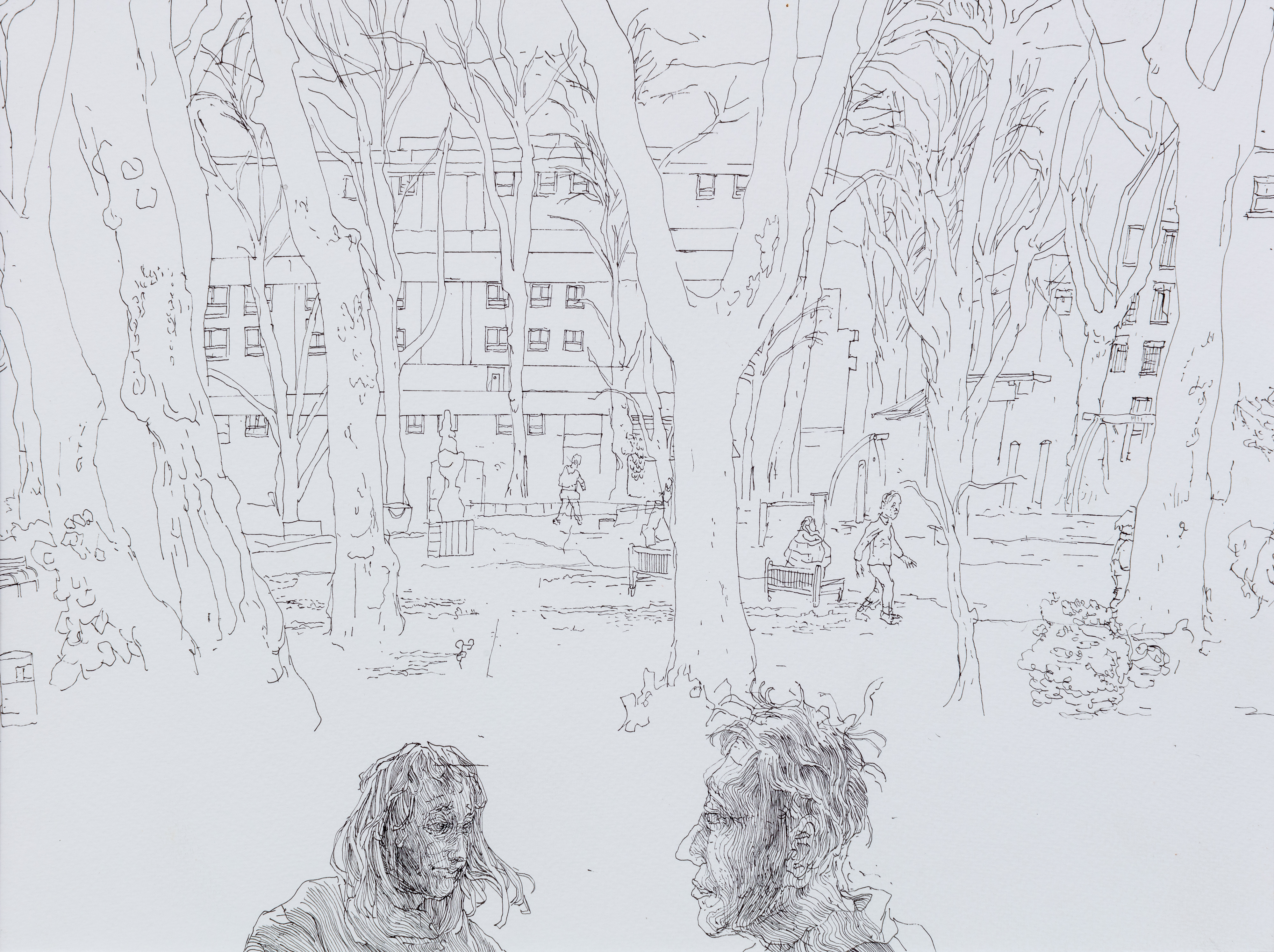
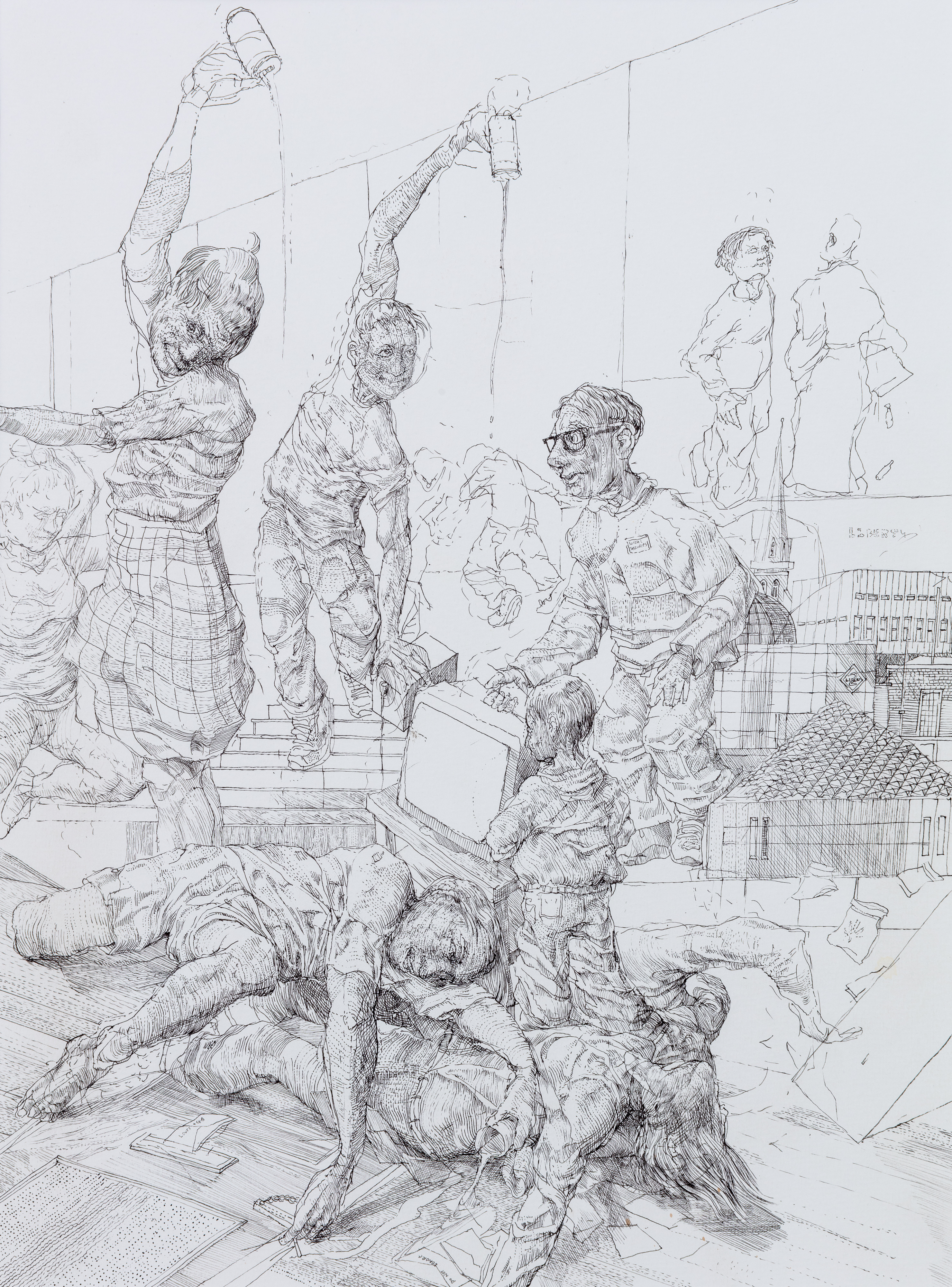








In between the actor and network (2023),
Inspired by actor network theory, the meaning of drawing and drawing with meaning in a constantly changing social system This artwork looks at the influence of the Share certificate on social culture. Within the view of actor network theory, relationships are primary, and objects emerge as nodes from pre-existing networks. Objects are what they do, or how they act through their distributed network.
The share certificate in this theory is as real as a solid wall; a node that defines the pathways people take through the city. Defining interactions as much as physical experiences. The city is the magnification of the shareholders desires and incentives. If the share certificate directly defines the work we do, then it also defines the phenomenon of life after work. Creating limitations on cultural appreciation and, therefore, British culture. The share certificate creates the base rules for billions of daily economic interactions and all commercial culture, public and private life.
The artwork plays with a sort of spiralling poetry, which amplifys the joys and tensions of human interactions within the expansive market system. The overwhelm of the dense commercial culture of London; between the coffee cups, the shoelaces, the joys and perils, the love, and the banality, in between the saltshakers, the radios, and the petrol station flowers, there are humans and love. The actors between all of the nodes.
The image itself is a social artwork because if is a new kind of share certificate. But it is as a practical, real device to accompany the articles of association of a new social architecture group called AB__ which I co-founded using a fair-share model - this form of multi-stakeholder social enterprise exists allow different forms of share distribution in land and housng and the production of cities. Therefore potentially resulting more equitable cities and architecture.
The Arts Cancel’ - 202


Capital city: the day the pound crashed in Liverpool Street.
On Thursday I spent some time practicing my observational drawing around the the banking sector in Liverpool Street. Growing up in London, I saw bankers moving on and off trains, spilling into pubs after work for my entire life. They vanish entirely on holidays.
Thousands of faces move in synchrony. Over time it culminates in the feeling of an ageless and eternal fleet as steadfast as the buildings of bank station.
Only when I got a bit older did I understand they weren’t just non-playable characters. Britain is one of the worlds largest exporters of financial services. Reading more about the economic system we live in you start to see how Issues within the global economy reflect themselves in the city of London. The wild volatility of human emotion and high irrationality of the global market are almost echoed in the daily expressions on the faces of the bankers. A secret mirror of the global market forces
This drawing was made during the time that the pound crashed to historic levels against the dollar, narrowly avoiding dollar parity. With everything happening in the world economy, you can tell if it’s a good or a bad day just by looking at the expressions of the bankers.



The material conditions of financial packages in greater london.
This piece looks at the urban housing conditions and lived experience in the Londons outer boroughs. On the edges of Greater London the psychological and spatial conditions merge so closely to become one single lived experience of deficit.
In the image I show a cul-de-sac of small terraces, a stranger smoking in a muddied parks grass, a man in the foreground opening a bill and holding a child. All of these are familiar moments of normality in the Greater London boroughs such as Barking and Dagenham and Redbridge. The image is a hybrid of familiar experiences growing up.
The Arts Cancel’ -
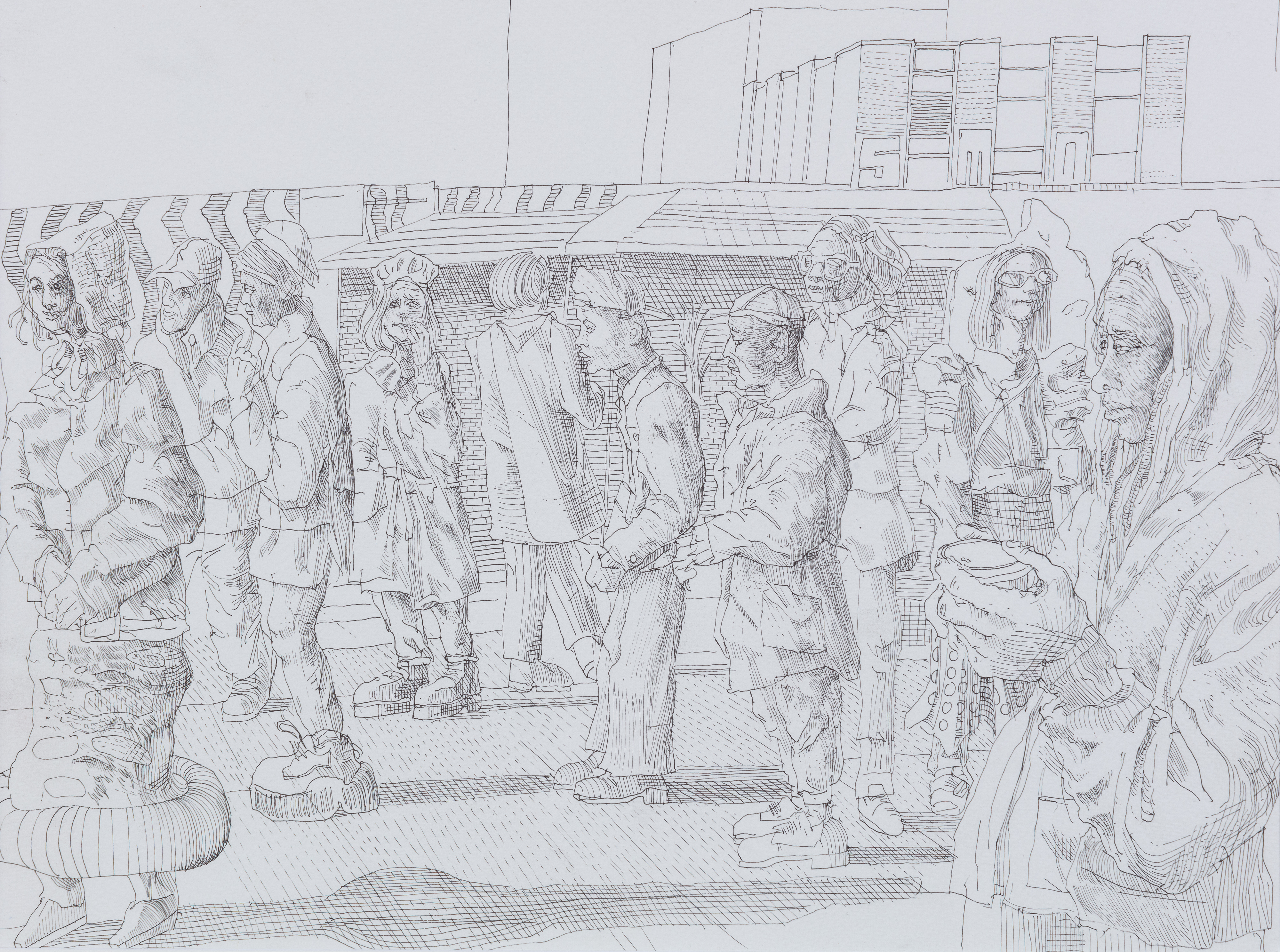



Manchester accident and emergency 2023 but instead with the doctors as avocados.
Recently I was exposed to Pierre bonnards pictures of his everyday life. They had bright colours and tones and imaginative moments. This is the language of beauty and memory. It got me thinking about how I could apply this way of representation to my everyday life too. After some conversations with jo, who is a doctor in accident and emergency, and after a trip to Manchester and visiting the A&E this weekend, I decided to try and represent Manchester hospital emergency department memories in these light and airy colours.
Currently there are 20 hour waiting times in accident and emergency despite some patients being excessively ill. There are varying degrees of trauma in the waiting room. Also there are about 4 managers to every doctor, making the resource allocation completely skewed.
The Arts Cancel’ - 202
Recently I was exposed to Pierre bonnards pictures of his everyday life. They had bright colours and tones and imaginative moments. This is the language of beauty and memory. It got me thinking about how I could apply this way of representation to my everyday life too. After some conversations with jo, who is a doctor in accident and emergency, and after a trip to Manchester and visiting the A&E this weekend, I decided to try and represent Manchester hospital emergency department memories in these light and airy colours.
Currently there are 20 hour waiting times in accident and emergency despite some patients being excessively ill. There are varying degrees of trauma in the waiting room. Also there are about 4 managers to every doctor, making the resource allocation completely skewed.
The Arts Cancel’ - 202
‘Bathing in the Peak District National Park for the mental wellbeing aspects.’



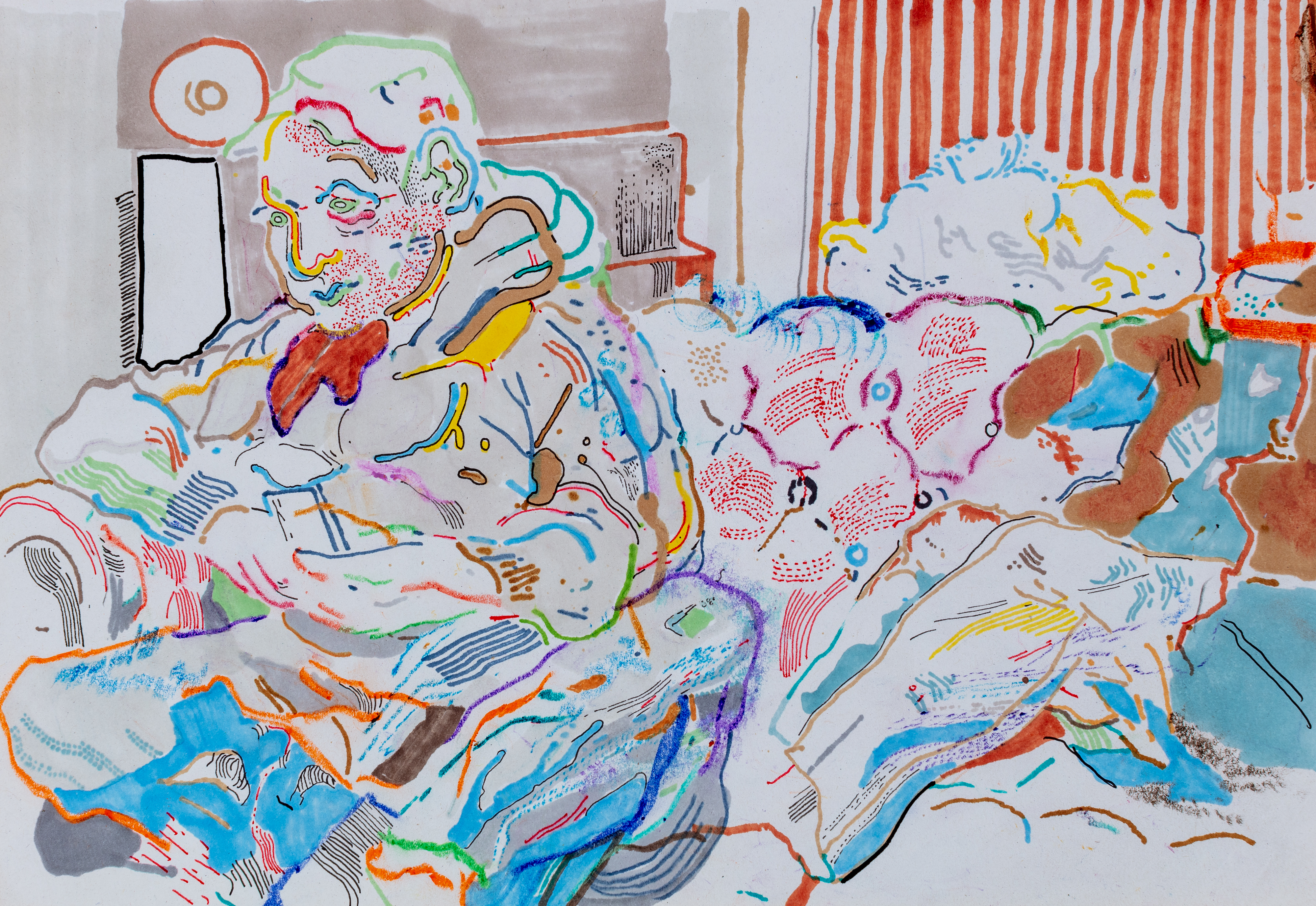

All drawings and paintings copyright of Louis Pohl (2023), photos of the work in studio copyright Tomas Folan Hasici.